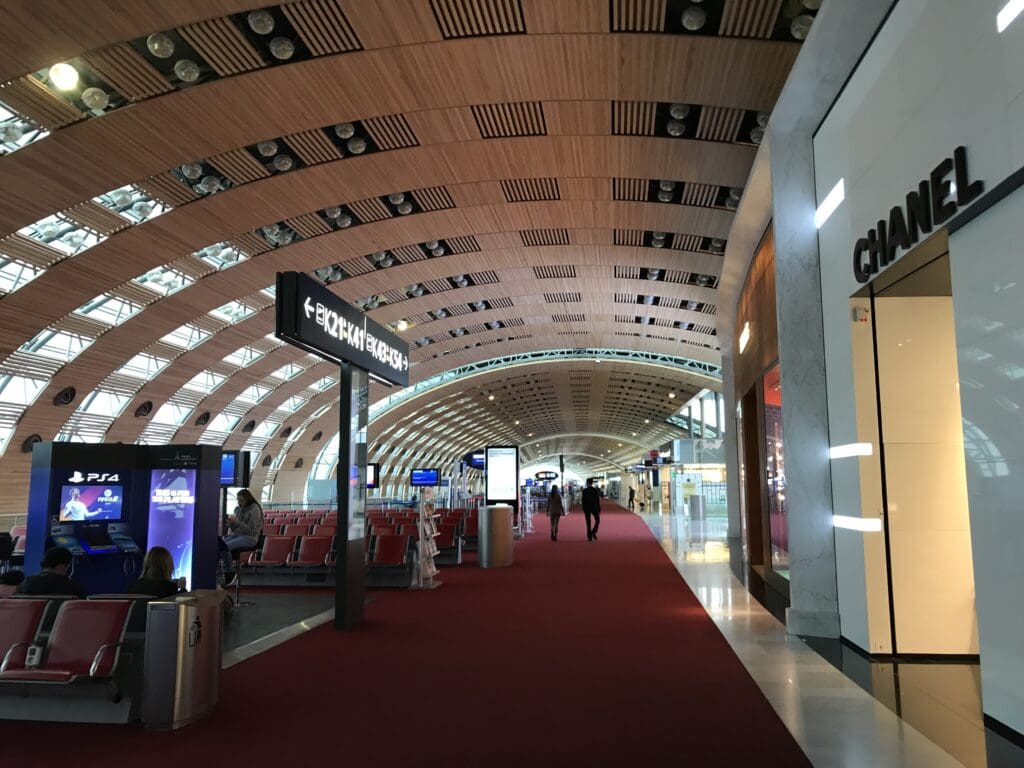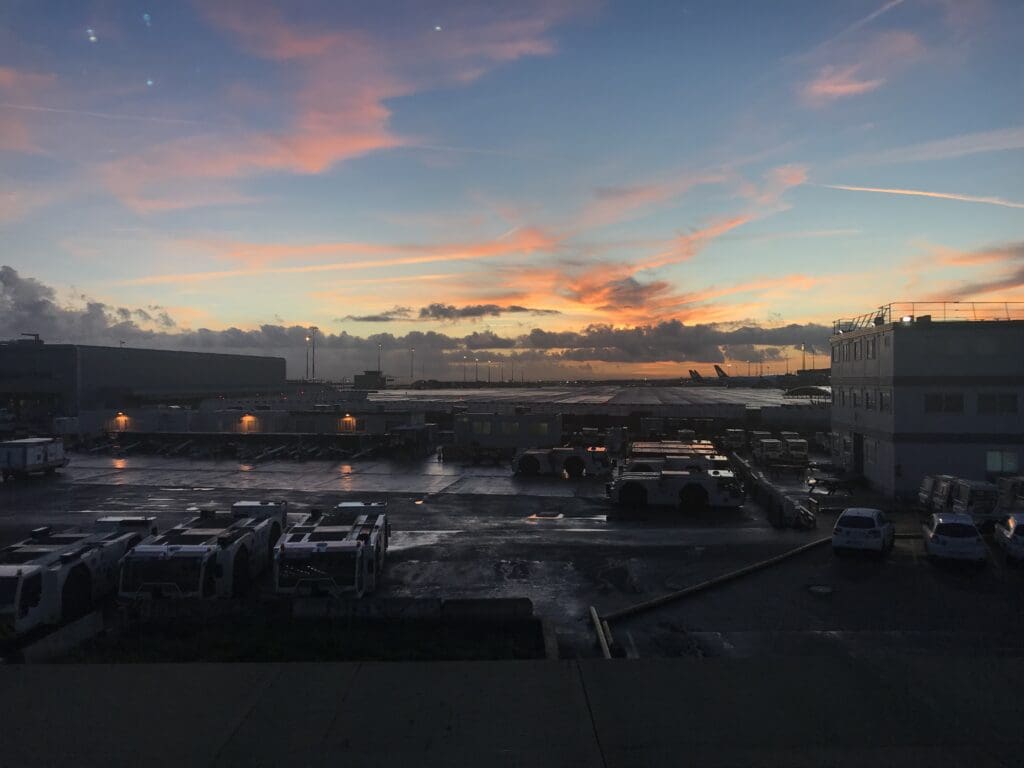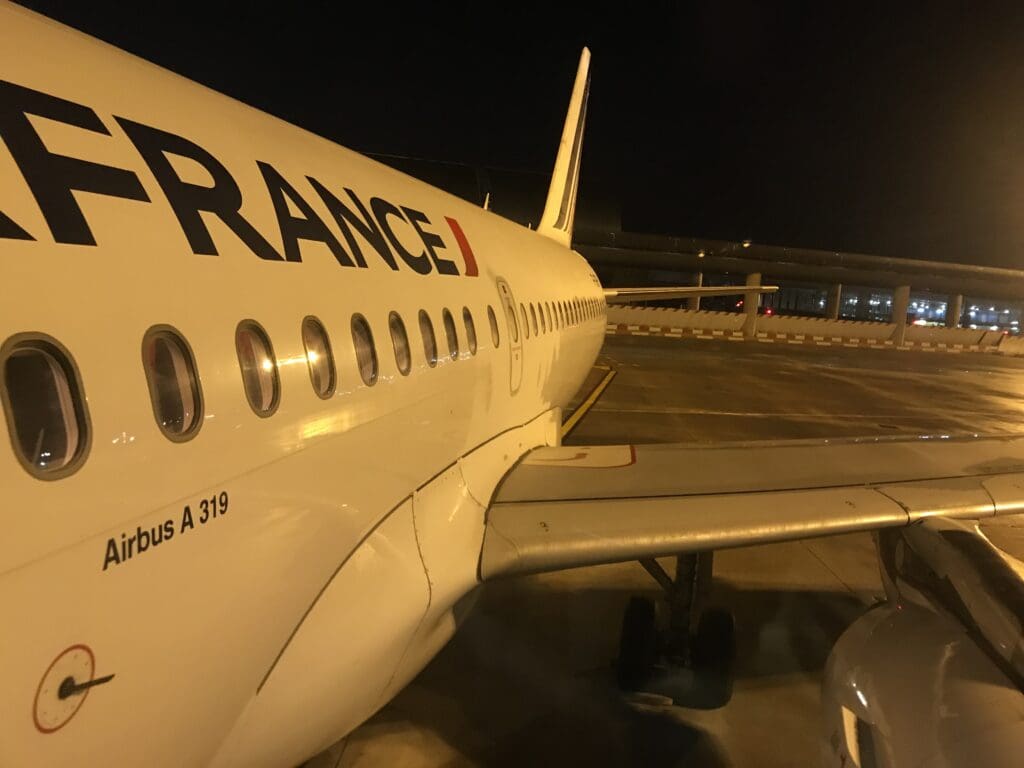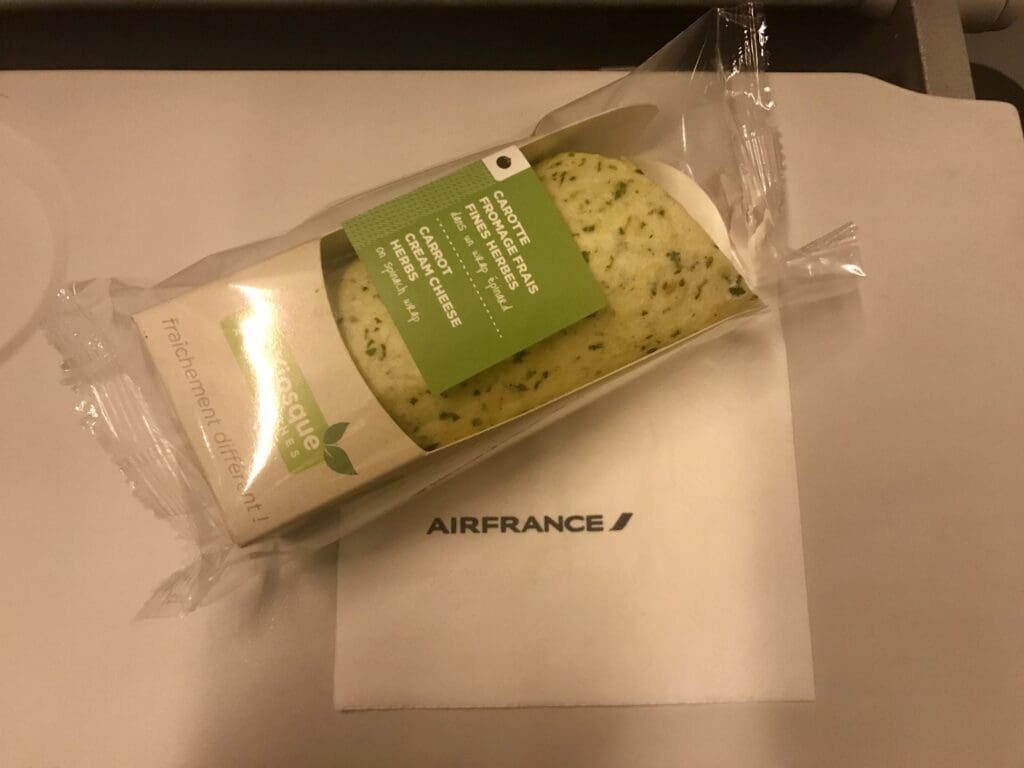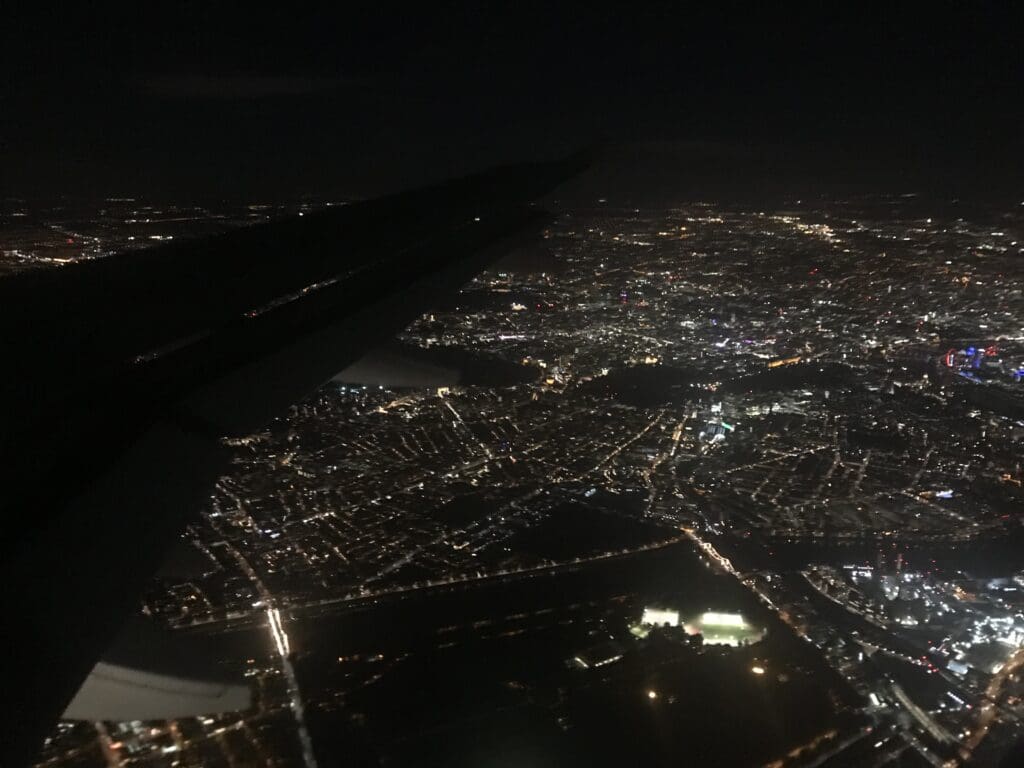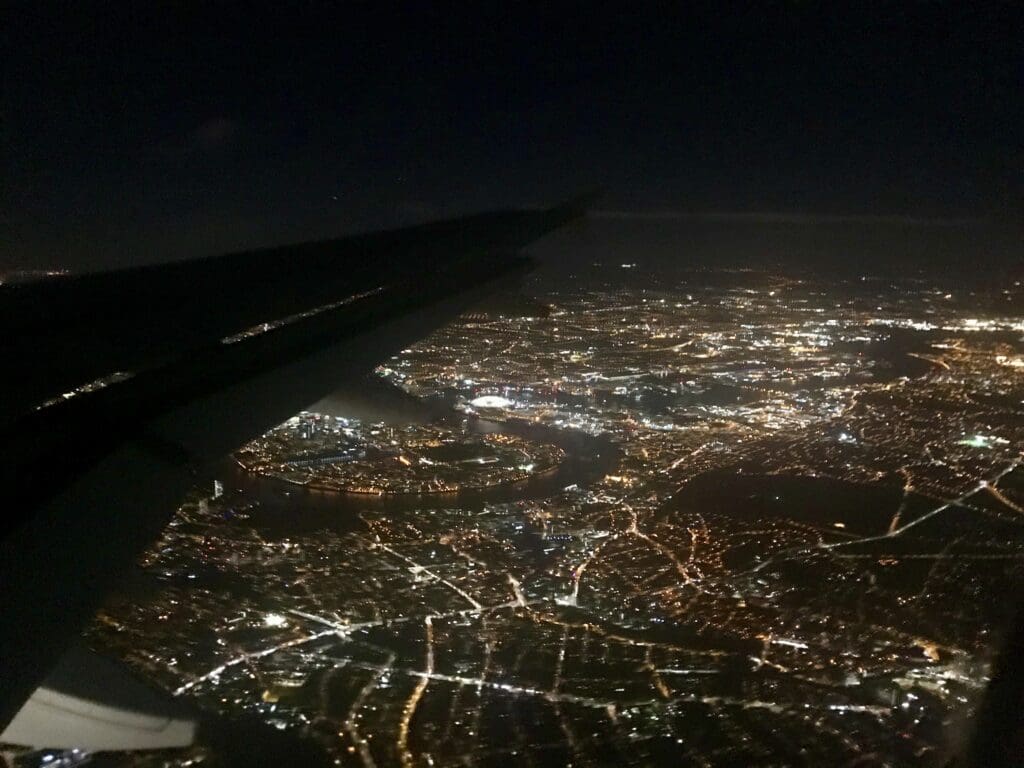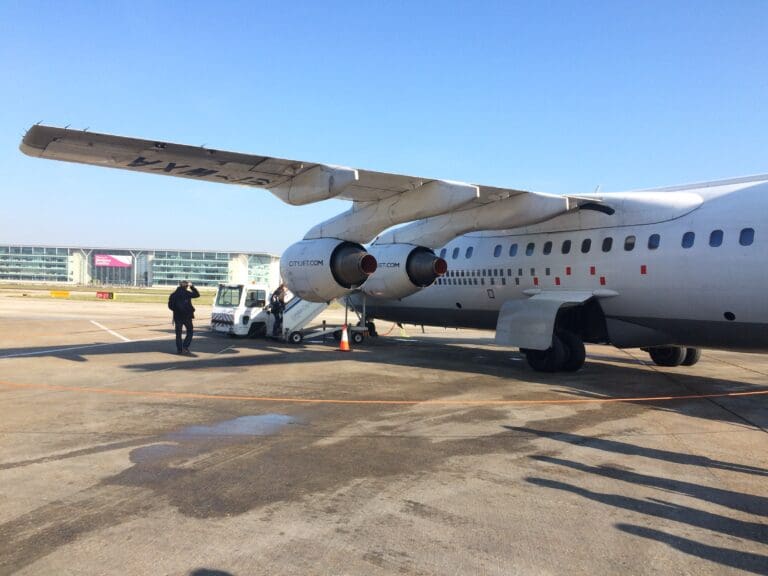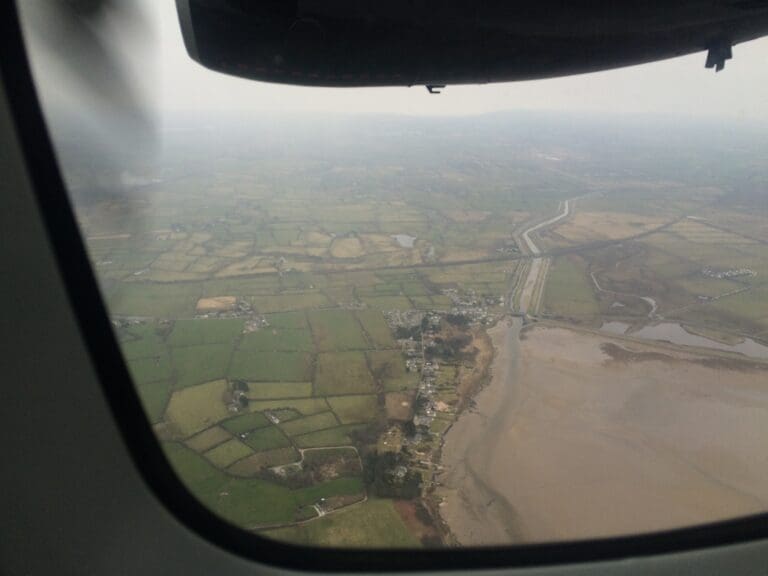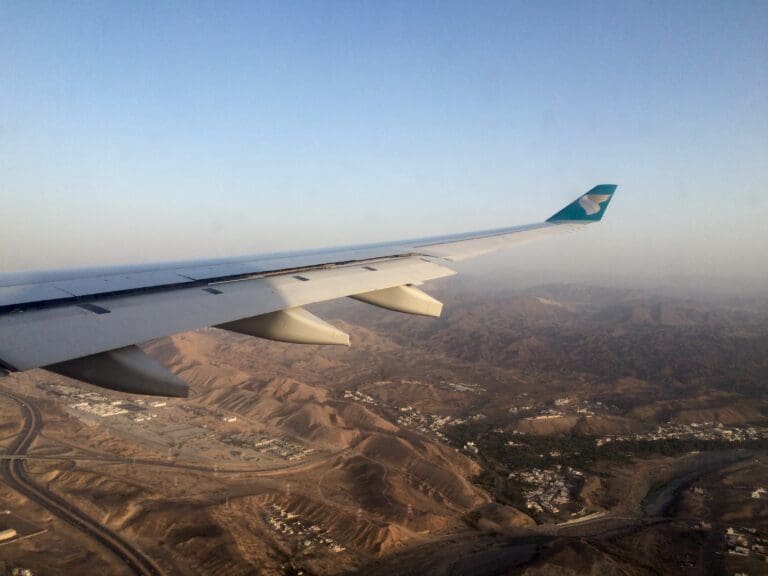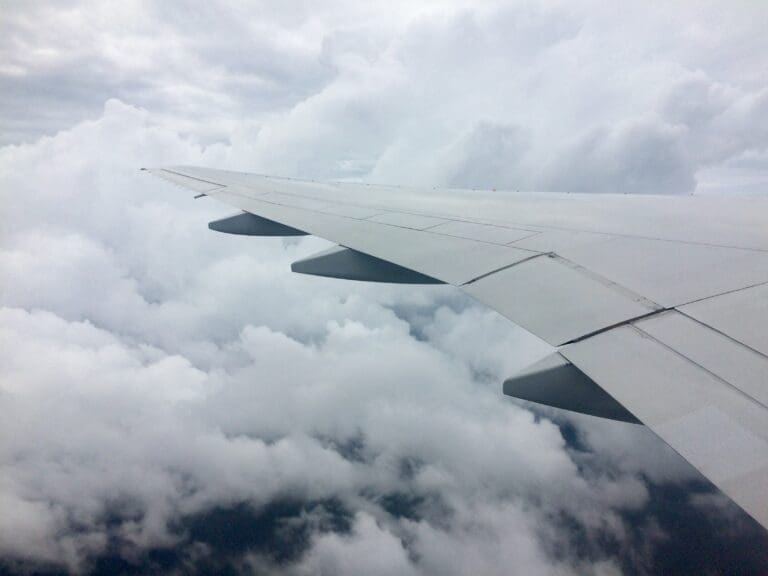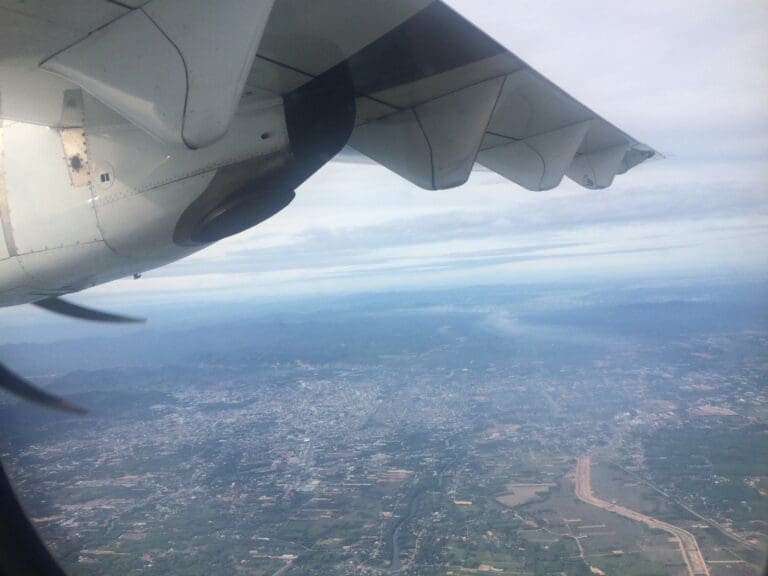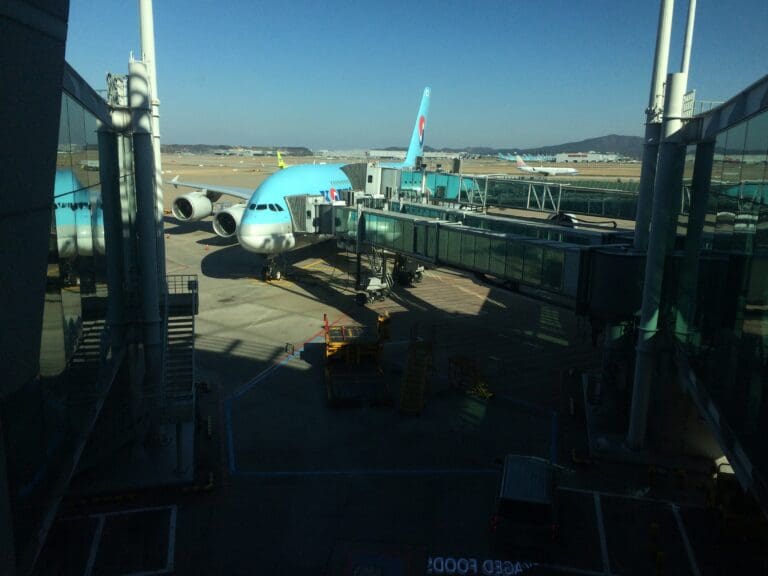Not Quite Air France: Flying a Rare BAe 146 with WDL Aviation – Nuremberg to Paris CDG
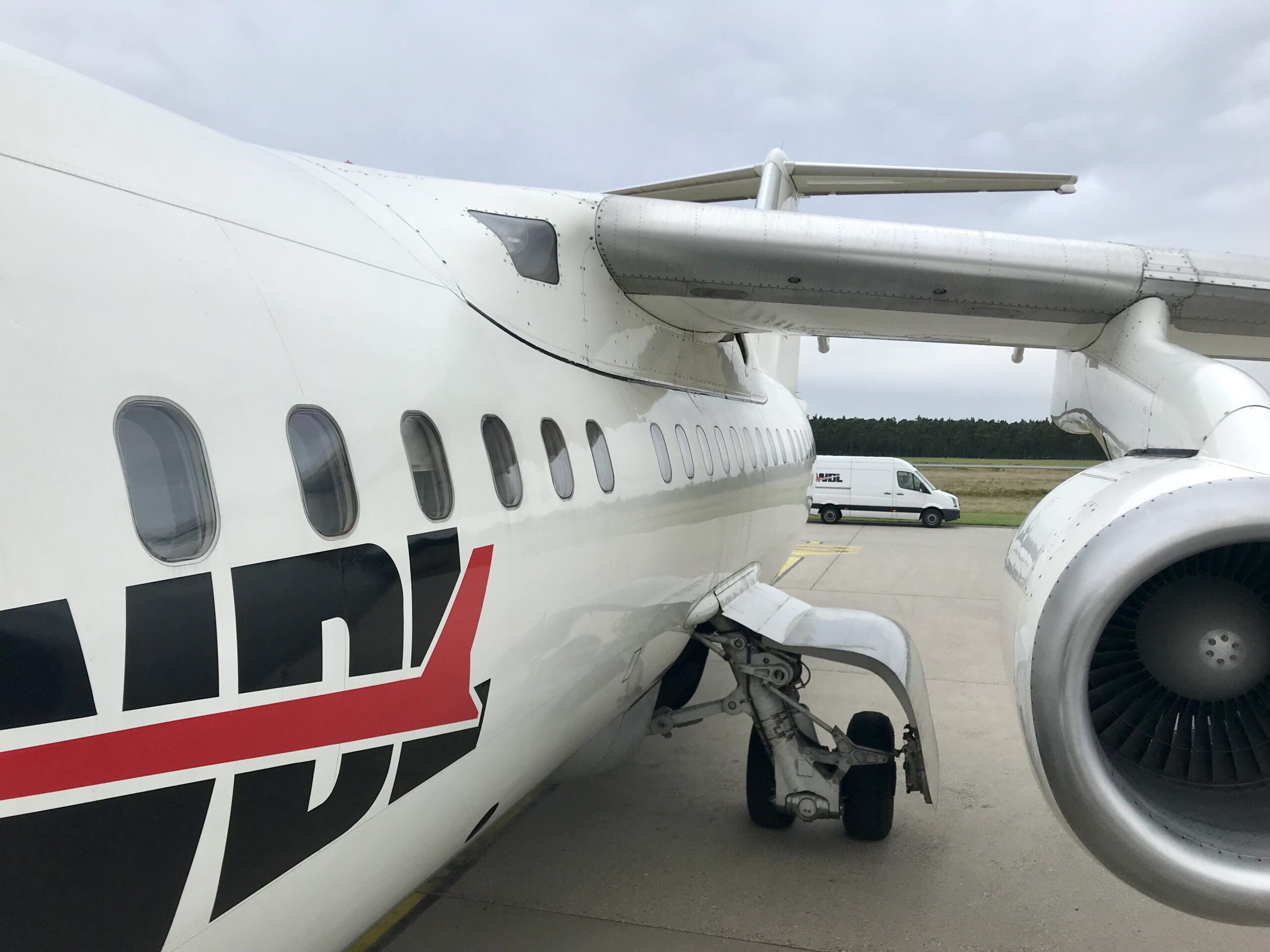
Given the BAe 146’s status as a rare aircraft no longer in scheduled passenger operation in Europe, when I discovered that German carrier WDL Aviation would be operating one of these rare quad-jets on scheduled services on behalf of Air France Hop!, I knew that I had to book myself onto one of these flights. After examining itineraries, I decided that the easiest and cheapest means to bag a ride onboard this rare jet was to fly from Nuremberg to London Heathrow via Paris CDG, and soon, I booked this service and was all ready to go.
Following a quick hop onboard a Ryanair Boeing 737-800 from London Stansted, I touched down in the Bavarian city of Nuremberg with around four hours to go until my flight to Paris CDG. Having plenty of time on my hands, I had initially pondered the idea of making a quick sightseeing trip to the city centre. Given the fact that the airport sits on the city’s U-Bahn network, getting to and from the city centre is quick, cheap and easy. However, having succumbed to a cold the previous day, I had spent much of the journey to Germany with a tissue held to my nose and with intermittent rain showers forecast to wash over the city throughout the day, I decided to pass the time in the terminal instead.
With no e-gates and all passengers forced to stand in line for one of just two open checkpoints, immigration took quite some time however eventually I made it through and was ready to explore the sights and delights of Germany’s ninth busiest airport. Wandering around, the landside portion of Nuremberg Airport seemed to be atypical of many regional airports across the country. Inside, plenty of shops, cafés and restaurants could be found, alongside a cornucopia of travel agencies. Whilst I did not find the terminal to be particularly architecturally spectacular in terms of its design, this was pleasant enough, with large windows in the ceiling ensuring that plenty of natural light flooded in, which, combined with the large atrium, gave the terminal a nice spacious feel. Yet perhaps more importantly, everything appeared to be fairly clean and tidy throughout, ultimately leaving me with no complaints. As I wandered around, the terminal seemed reasonably quiet, with few passengers milling around the landside portion. Many of those who were there took the form of American soldiers who I assume had something to do with the Atlas Air Boeing 767-300ER that I spotted on the ramp.
Unlike Britain, German airports are generally well-catered to planespotters, with most airports having an observation deck either in the terminal or elsewhere on the airport grounds. Fortunately, Nuremberg is no exception and after I had exhausted the other sights of the terminal, I made my way to the top floor and set up camp for a couple of hours. Admittedly, Nuremberg Airport does not usually provide any movements that are particularly exciting for a British spotter, however, credit must most certainly be given for the panoramic views offered from the observation deck, with both the runway and many of the terminal’s stands visible. During my stay, a reasonably constant stream of aircraft passed through Bavaria’s second-largest city. These included several Dash 8 Q400 sporting Air Berlin’s red and white livery (albeit operated by Luftfahrtgesellschaft Walter), Airbus A319s and Airbus A321s operated by Berlin-headquartered leisure and charter airline Germania, several Lufthansa CityLine Bombardier CRJ-700s operating very short hops to Lufthansa’s hubs at Frankfurt and Munich, alongside a healthy number of Ryanair Boeing 737-800s and private jets. Many of the latter were operated by the locally based FAI rent-a-jet, who specialise in both luxurious on-demand charters and air ambulance services for those unfortunate enough to fall ill away from home or require specialist treatment in another country or region.
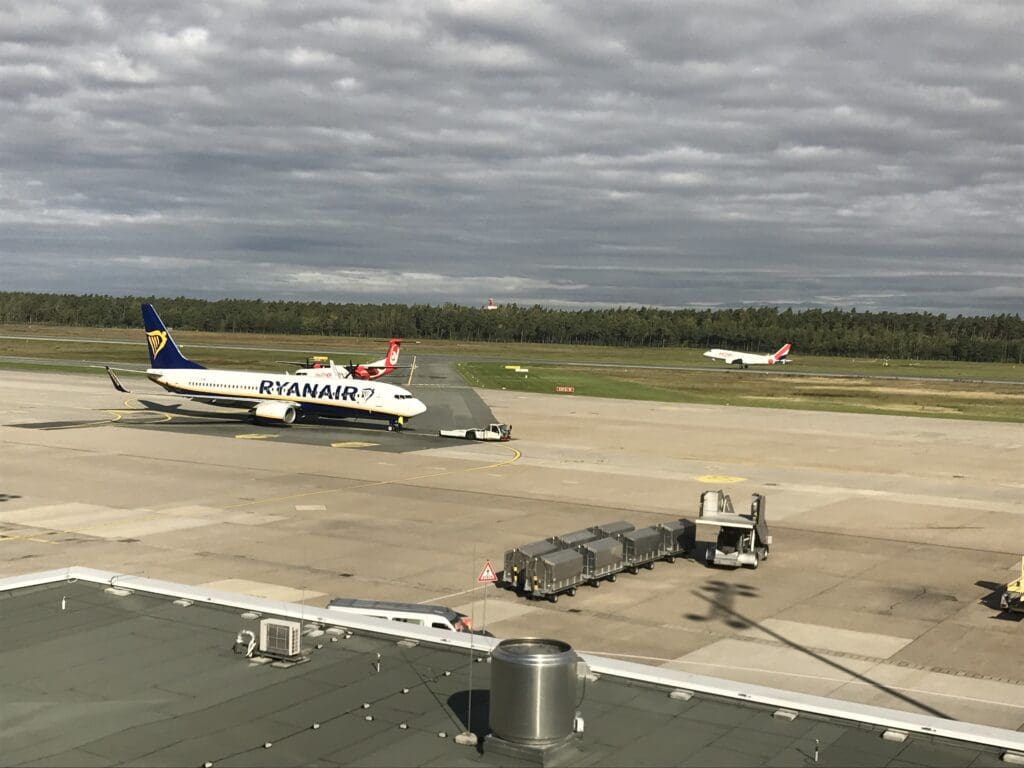
Eventually, I thought it wise to return to the check-in hall. As at many airports, Air France and KLM share a check-in area, and with a sizeable operation consisting of nine flights each weekday, unsurprisingly this was well-branded and featured plenty of the two airlines’ branding. Interestingly, despite the airlines’ high number of flights, there were no check-in machines available at the airport and instead, just two check-in desks were on offer. Having checked in online via Air France’s app and with no bags to drop off, with a significant queue leading up to the two desks, I decided to instead head straight to security. With few passengers passing through security at that time, I was soon able to pass through this before heading up the escalators and making my way to the main airside departure area.
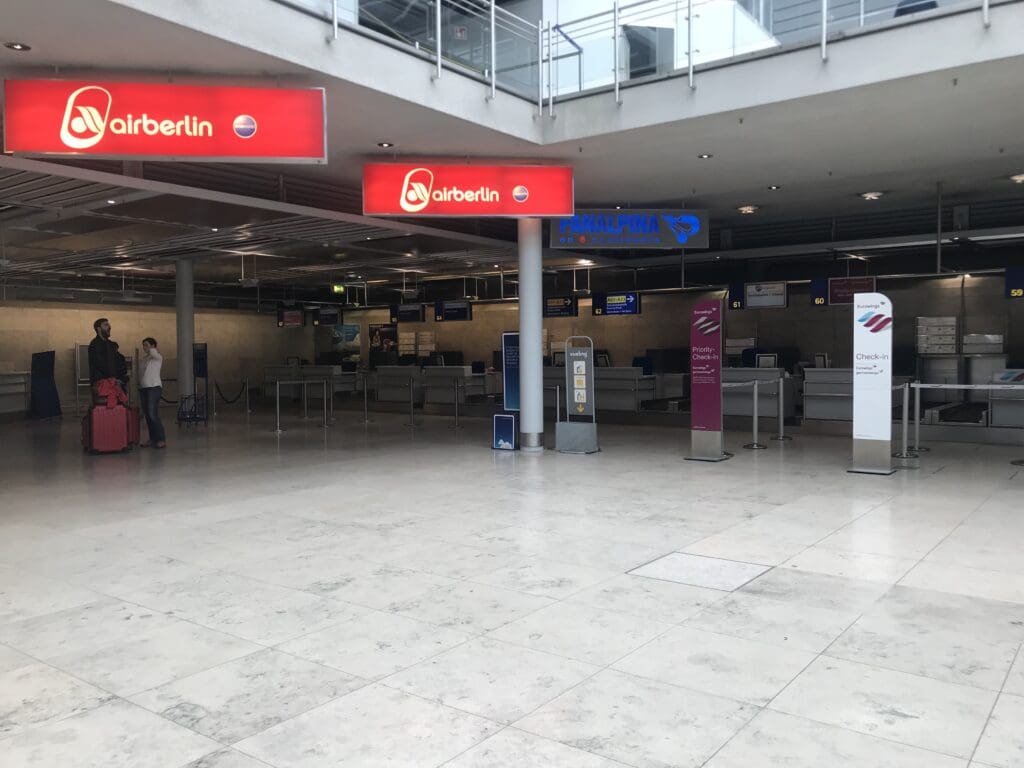

Once airside, I found this part of the terminal to be a little more modern than the landside area and featured plenty of places to sit and wait. This was clean and tidy, and thus ultimately I was left with very little to complain about other than the apparent lack of charging points. When it came to shops, this featured the usual array of duty-free stores selling both your usual selection of items plus a selection of local goods. Several cafés were also offered, selling an array of drinks and light bites albeit with the usual airport mark-up.
Upon arriving in the airside portion of the terminal, just one aircraft could be seen parked up at one of the stands outside. This took the form of a somewhat weathered-looking Boeing 737-400 operated by Slovakian ACMI specialist Go2Fly, with this operating a flight to Thessaloniki on behalf of leisure airline Niki. This was soon joined by a Germania Airbus A319 that would later head off to Faro and a new sharklet-fitted Lufthansa Airbus A320 operating the short 118-mile rotation from Frankfurt. This was one of five flights from Nuremberg to Frankfurt that day, whilst the airline also operates four daily services to Munich, located a mere 86 miles to the southeast!
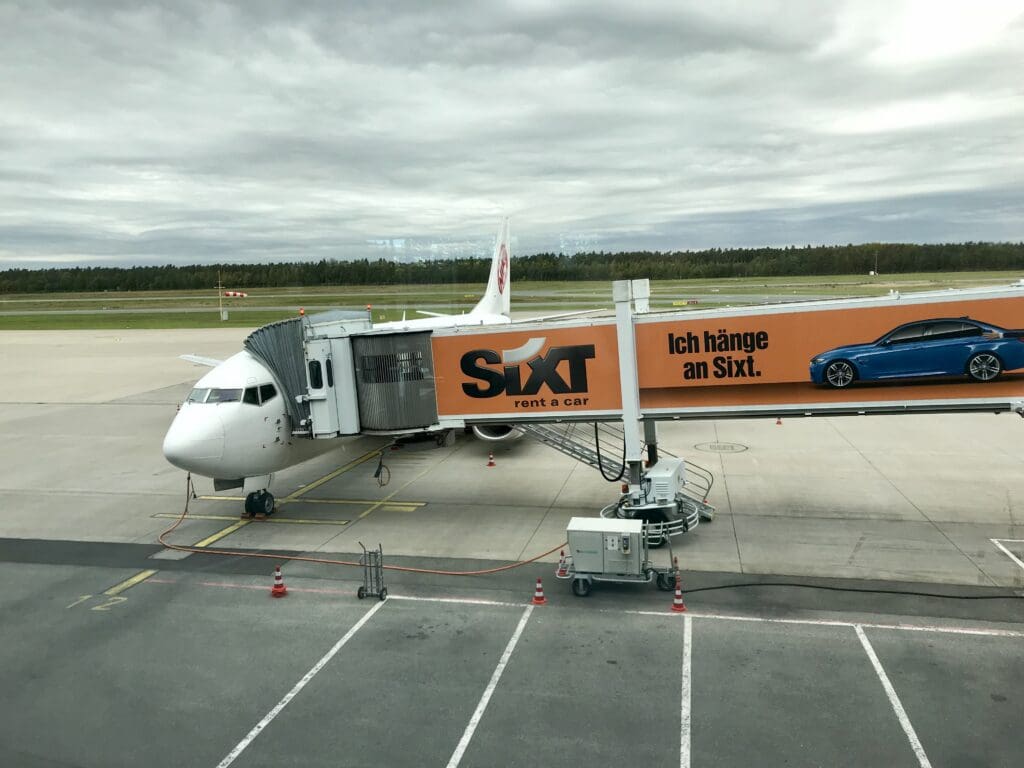
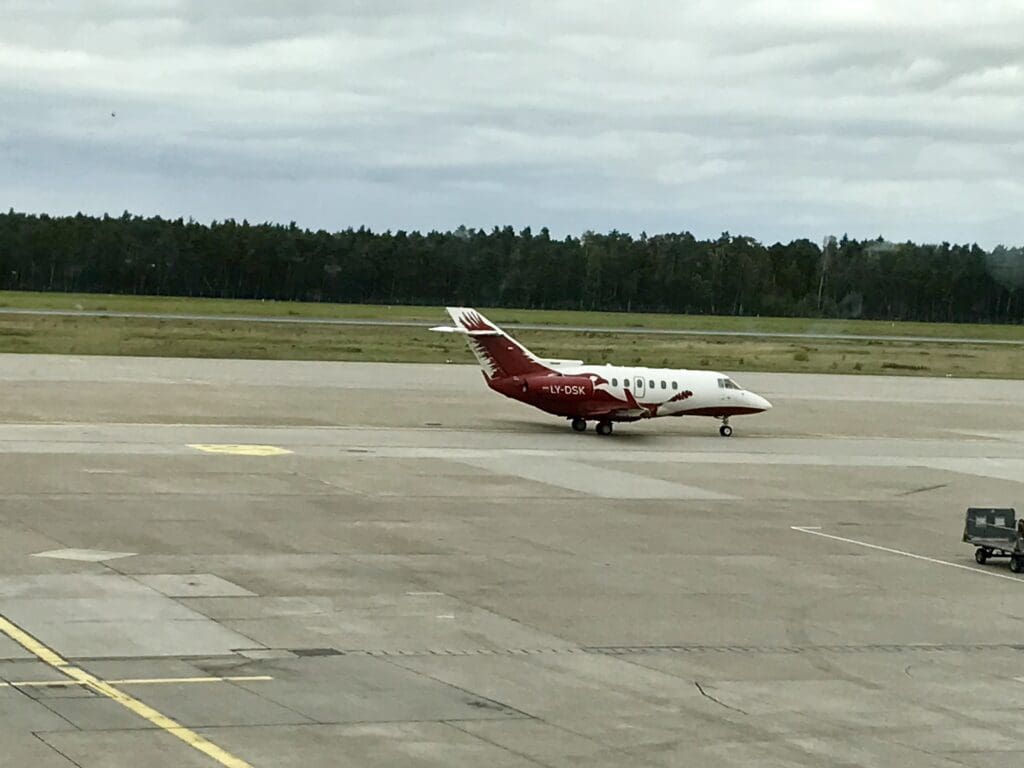
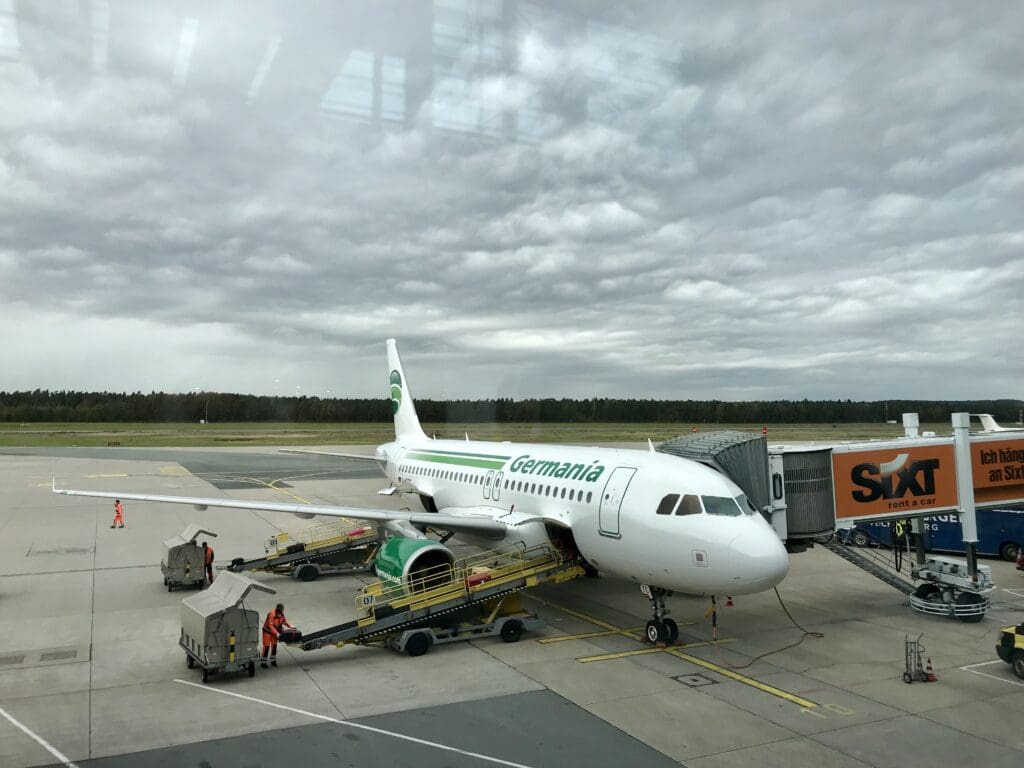
Outside, two small business jets came streaming past the terminal on their way to Runway 28. The first was a small Cessna 510 belonging to Norwich-based SaxonAir and the second was a larger and interestingly painted Hawker 850XP belonging to Lithuanian operator, Classic Jet. At 1411, I watched as our short and stubby British Aerospace 146 made what seemed to be like a smooth touchdown on Runway 28 after its short flight from Paris CDG before it made a quick taxi to remote Stand 32, parking next to an American registered Falcon 7X. This aircraft most certainly did not sport one of the most colourful liveries in the skies, painted mostly white with WDL Aviation’s simple logo under the cabin windows at the front of the aircraft, the airline’s motif on the tail and a German flag next to the registration.
My aircraft for the flight came in the form of BAe 146-200, D-AMGL. This four-engine jet made its first flight from British Aerospace’s Hatfield site with the registration of G-5-055 on the 12th of May 1986, making it thirty-one years and five months old at the time of my flight, and was thus the second oldest airliner that I had had the pleasure of flying on at that time. On the 2nd of June 1986, the aircraft was delivered to AirCal where it spent a year flying around California as N145AC before the airline merged with American Airlines in 1987. The aircraft continued to fly in the US with American Airlines, changing its registration to N697A in 1989. In 1994, the aircraft returned to Europe to start a new life with Swedish airline Malmo Aviation, flying with the company for seven years before being handed to BAe Systems Asset Management in October 2001 where it was given a British registration and placed in storage at Exeter Airport. Fortunately, in April 2003 WDL Aviation took up the aircraft and it has been in the skies of Europe ever since, making WDL Aviation the longest operator of the airframe. In the week before my flight, the aircraft had flown around 15,200 miles over 48 flights on behalf of Air France connecting Paris CDG with Basel, Frankfurt, Nuremberg, Pau and Stuttgart.
According to AvHerald, D-AMGL had suffered from a single incident during its life in Germany. This occurred in August 2015 when, upon touching down in London City, a hard landing resulted in one bolt from the shock absorber going missing and piercing the right main landing carriage door in the process of flying off. The fractured bolt was determined to have occurred due to fatigue and WDL Aviation came under fire for not replacing bolts that had exceeded their maximum number of cycles.
As the scheduled boarding time of 1420 neared, passengers gathered around Gate 13. At 1427, seven minutes behind the advertised time, boarding was called and an orderly line of eager passengers formed. Most of these appeared to be business travellers however a significant number of passengers were heading onwards to China. After waiting for a few minutes, I had my boarding pass scanned and made my way down the stairs onto the already-packed bus. A couple of minutes later once all passengers were onboard, the doors slid shut and we were off! The journey across the apron took no more than a minute and after passing by a recently arrived BMI Regional Embraer 145 bound for Birmingham, we pulled up on the port side of our Jumbolino. The doors then opened and passengers streamed off towards the front door of the aircraft. Most passengers seemed to be unfazed by the aircraft, to them it was just a means of getting from A to B, as long as it flew, it was no different from any other airliner. Yet a few passengers seemed to be taking photos of the aircraft as we boarded, I wondered whether they knew about the aircraft’s rareness.
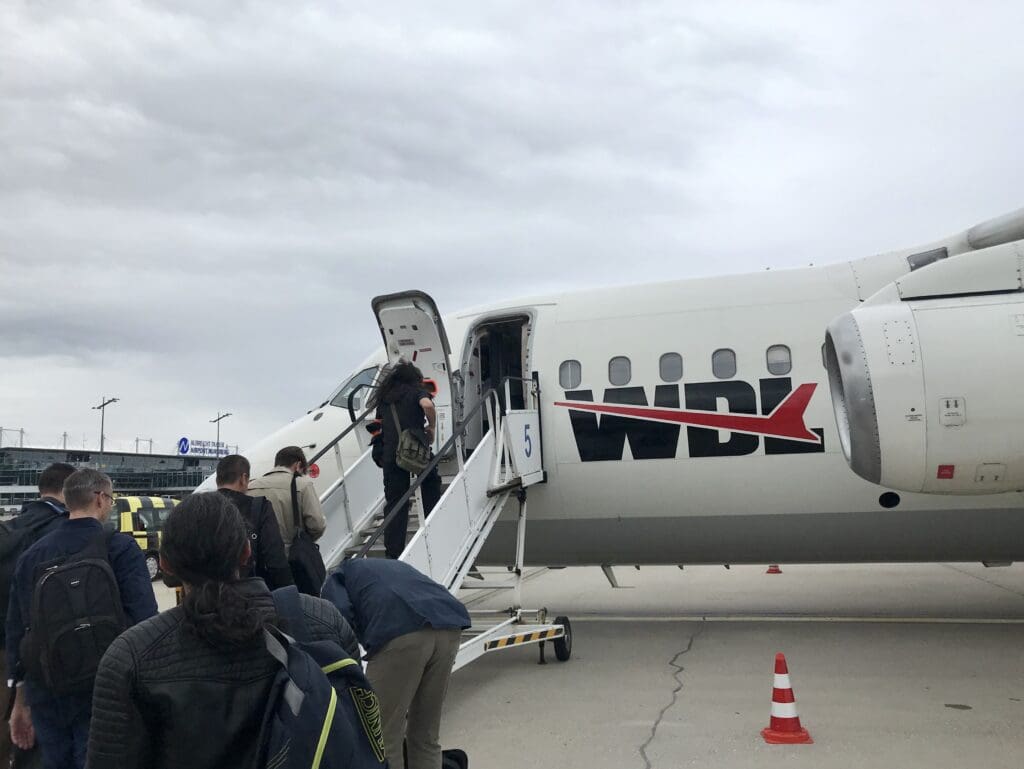
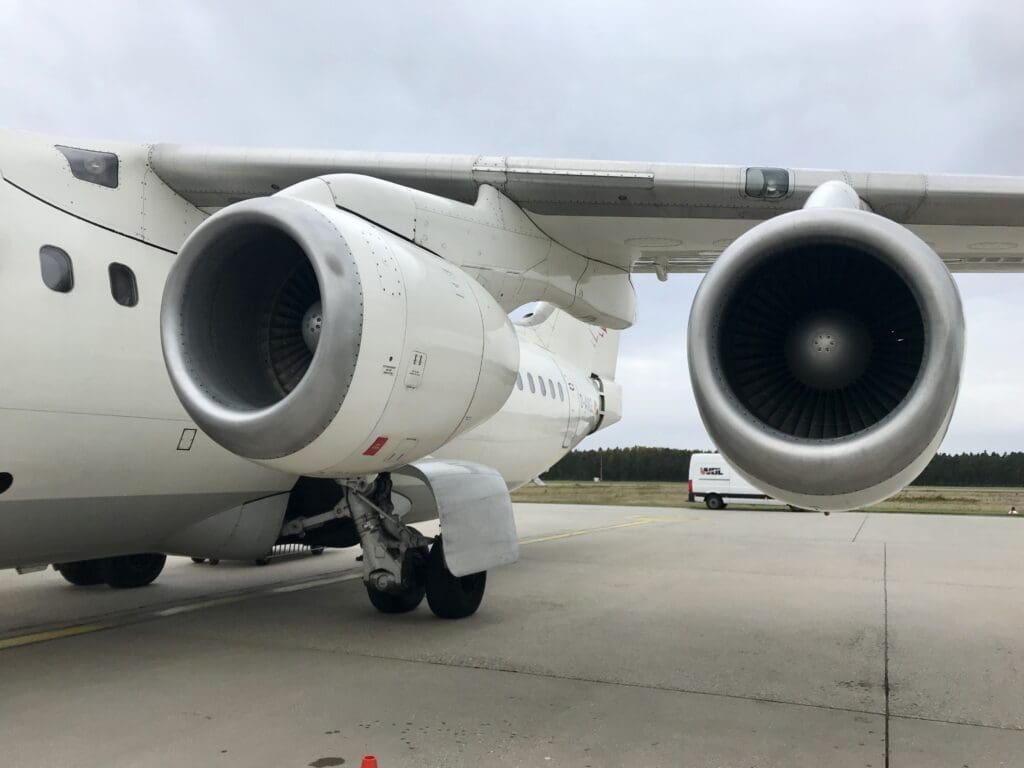
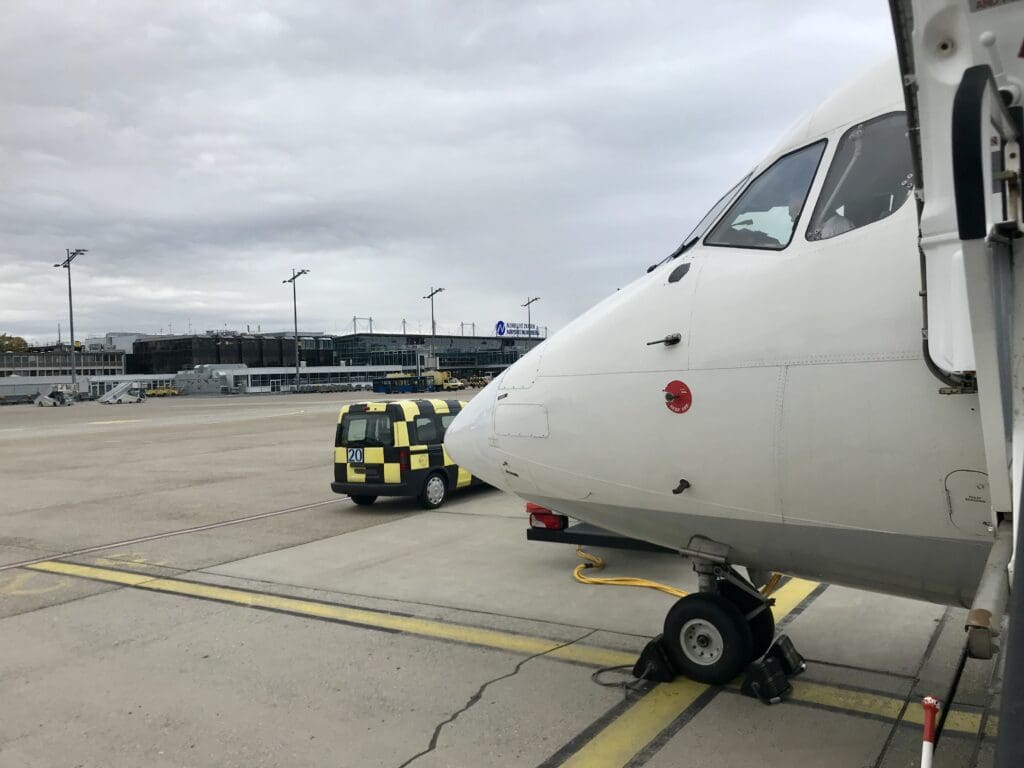
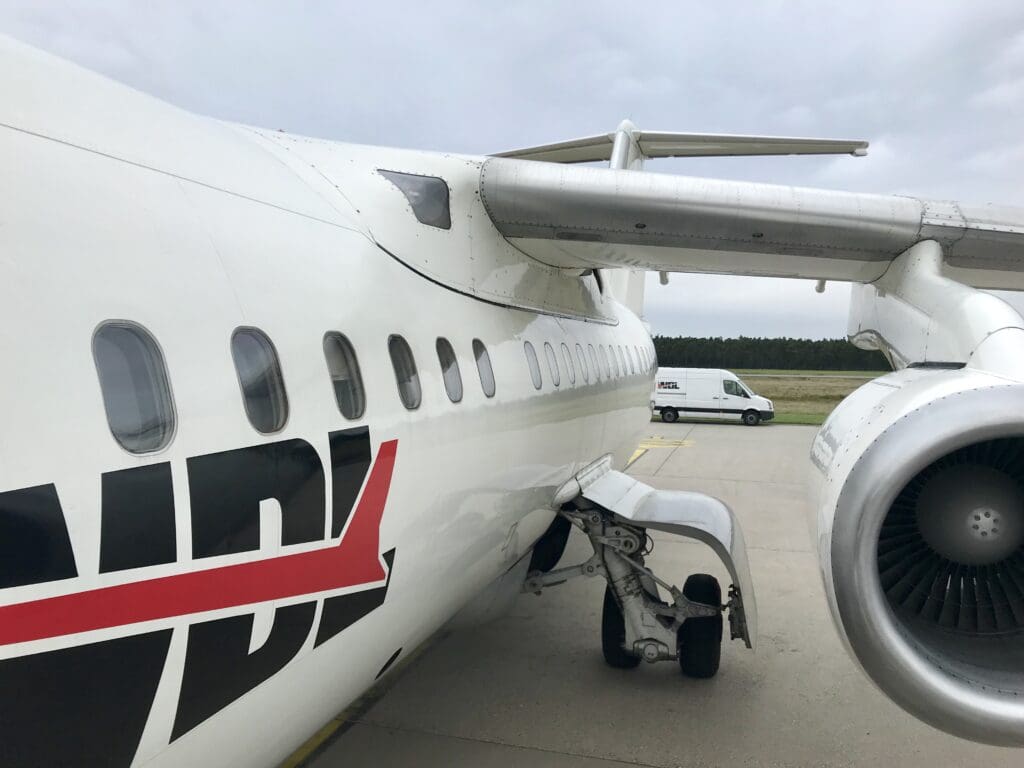
As I waited just outside the door, I noticed the first unusual feature of the aircraft’s interior, a full mirror toilet door, something which whilst it makes sense, I have never seen on an aircraft before. After stepping aboard, I glanced left and was treated to a quick peek at the vintage-looking grey, fully analogue cockpit. I was then greeted in French by the Purser before heading into the cabin to Seat 14F.
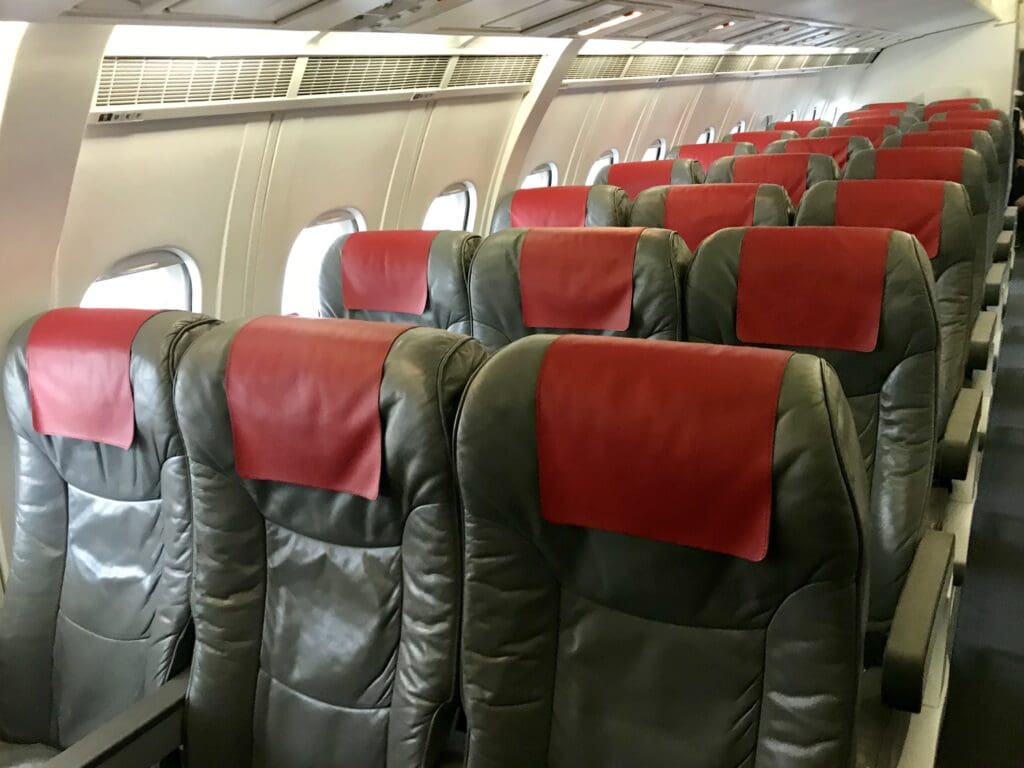
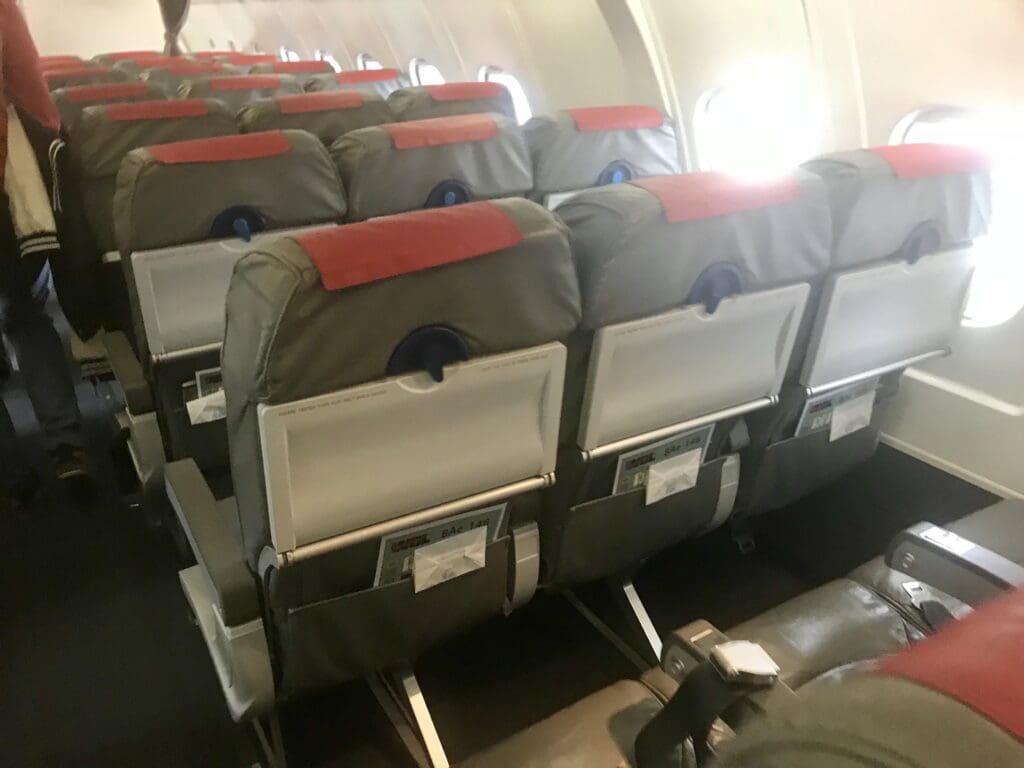
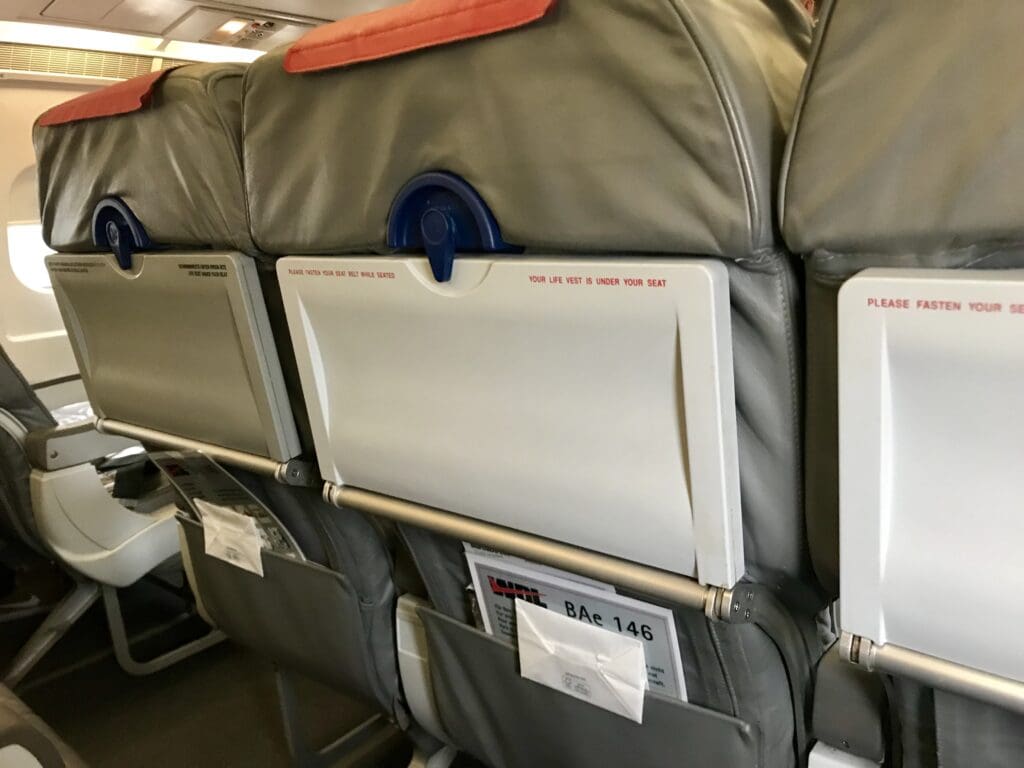
Whilst many passengers were likely blasé as to the rarity of the aircraft, even to the non-expert, some things set this aircraft apart from your average Airbus, Boeing or Embraer. Onboard, there are no dainty lightweight seats, and instead, each of these is large and welcomingly well-padded. On a modern jet, even those passengers who like to push the boundaries for the size of cabin luggage may well be able to face no issues in fitting their small suitcases into the overhead lockers, however, such passengers would have likely been out of luck on this older aircraft. Instead, this aircraft featured small, square overhead lockers that protrude into the aisle when opened. If you need to rely on mood lighting to calm your nerves as you board, you’ll have to rely on the yellow-orange glow of the aircraft’s lighting system to do this, and despite the ashtrays in every armrest, you most certainly cannot use a cigarette onboard to do this! Finally, you most certainly cannot use any buttons to dim the windows and must use two blinds to do this, one from the top and the other from the bottom. Each seat was covered in a grey leather cover and came complete with a red leather headrest cover. Not only was this seat comfortable, but it also featured a fantastic amount of legroom that would have proven to be sufficient, even on a long haul flight! Importantly, the aircraft appeared to be clean and despite its age featured a surprisingly lacking amount of wear and tear. Turning to the seatback pocket, this contained a WDL Aviation BAe 146 safety card, a copy of Air France’s inflight magazine named ‘Magazine’ and an Air France branded sick bag. Ultimately, my only complaint was that the window was blurry and scratched, making any decent photos through this being rather difficult.
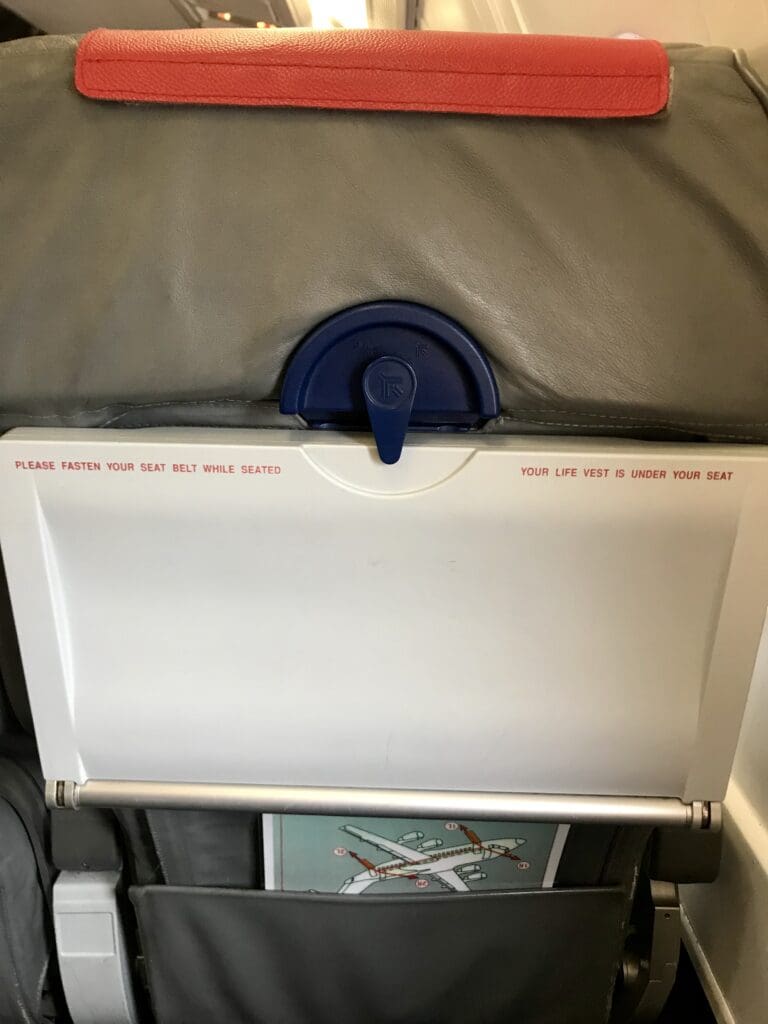
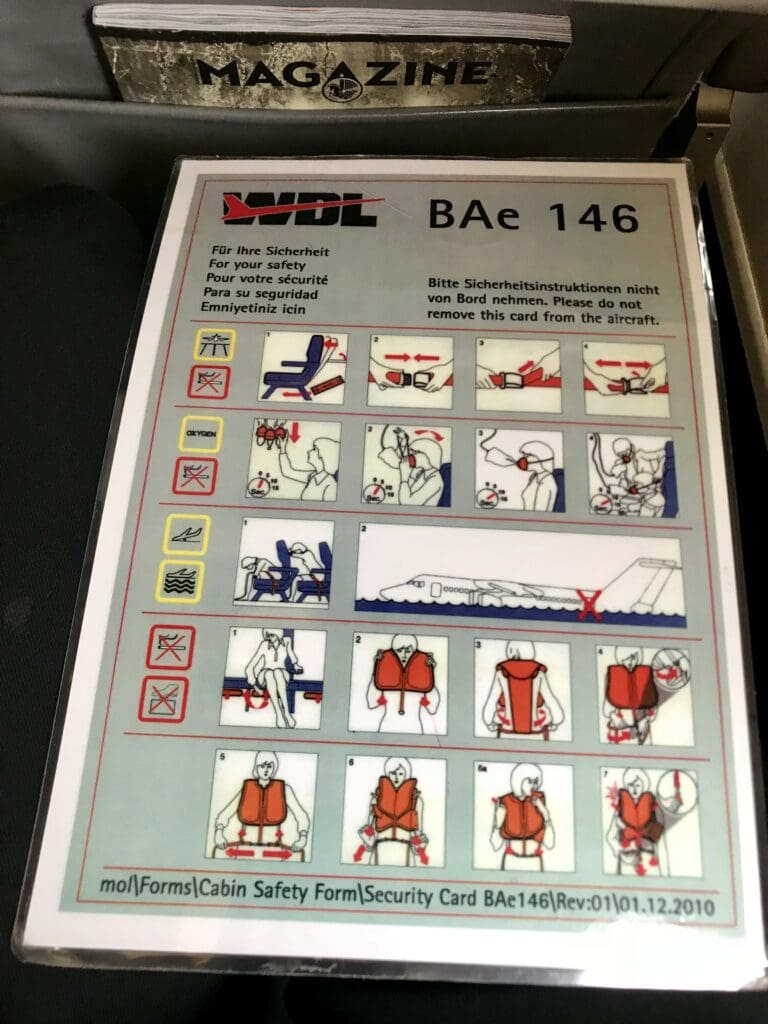
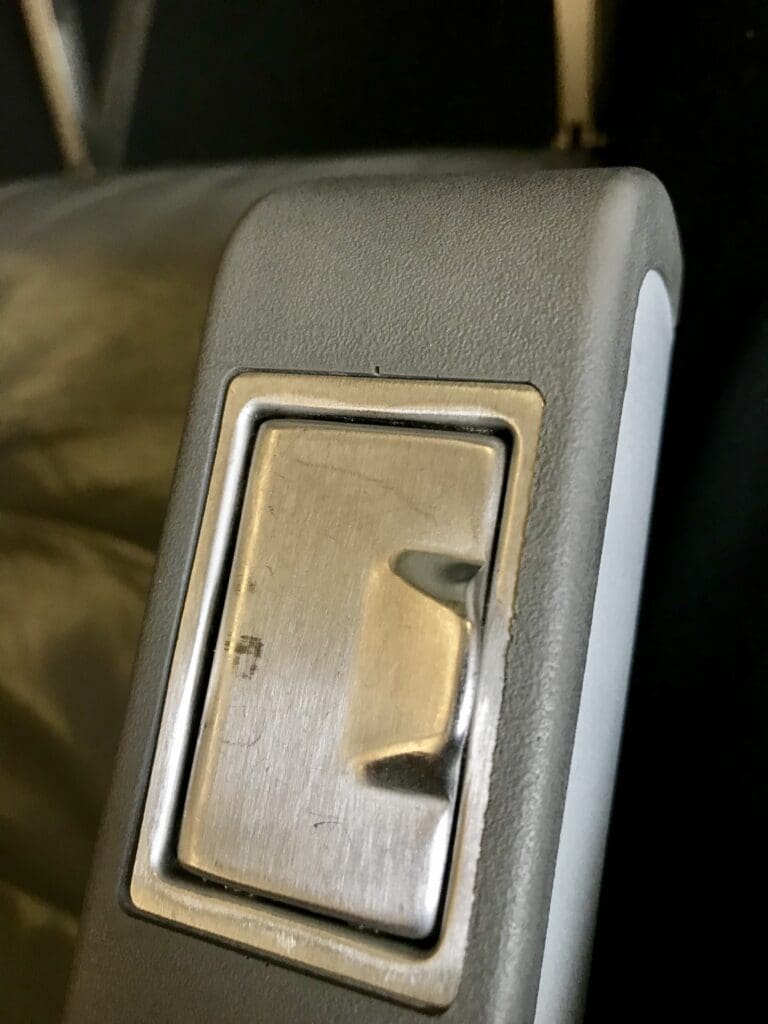
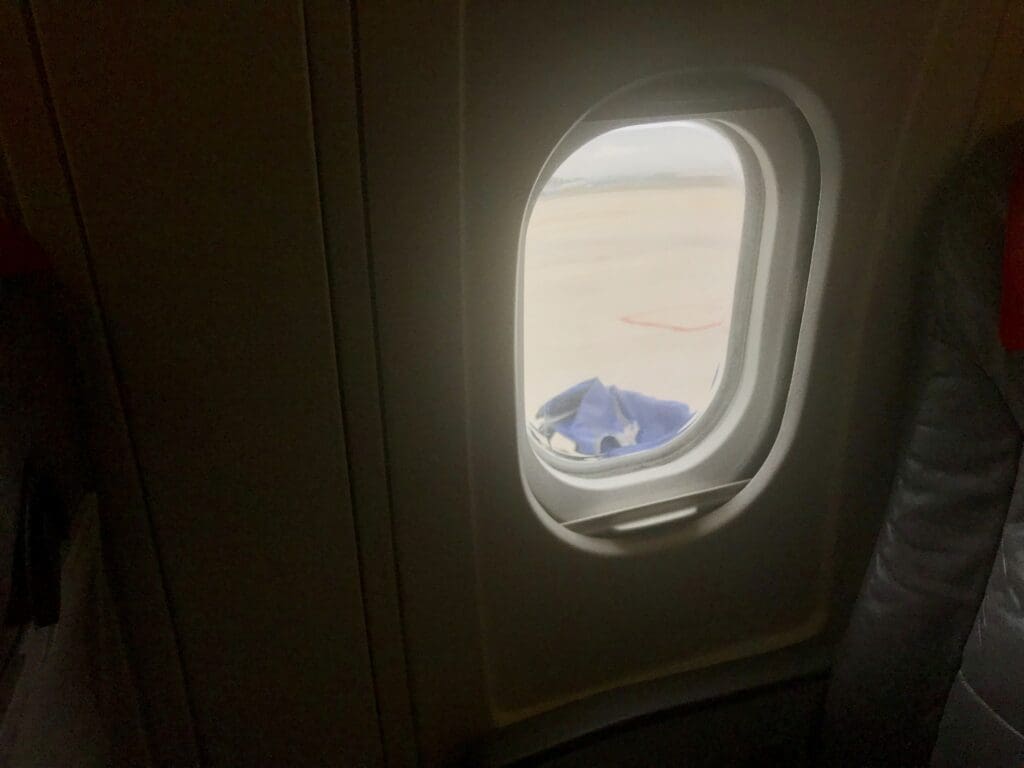
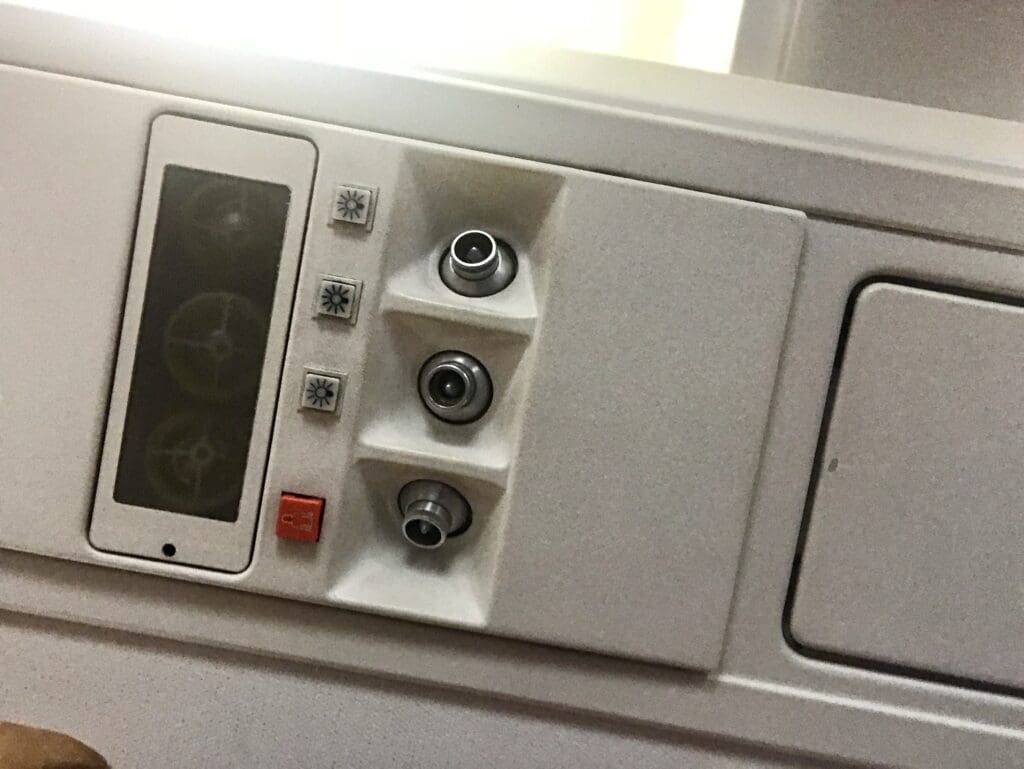
Onboard, the three flight attendants appeared to hail from Germany, one of whom, the Purser spoke both French and German. By 1449, four minutes after the flight’s scheduled departure time, all passengers had boarded the aircraft, the dispatcher had vacated the aircraft and the cockpit door was closed, with the main cabin door soon being closed with a large thump. Within a minute, the Captain made an enthusiastic announcement in English welcoming us onboard this ‘British Aerospace Jumbolino service’ and advised us that due to strong headwinds, the flight time would be an hour and twenty minutes. Interestingly, the actual flight time of this flight seems to vary quite greatly, for example in the two weeks before my flight, the longest flight was around 1H40, whilst the shortest flight lasted just over an hour. The Purser then conducted a welcome announcement in French, English and German, welcoming us onboard before performing a short but detailed safety demonstration.
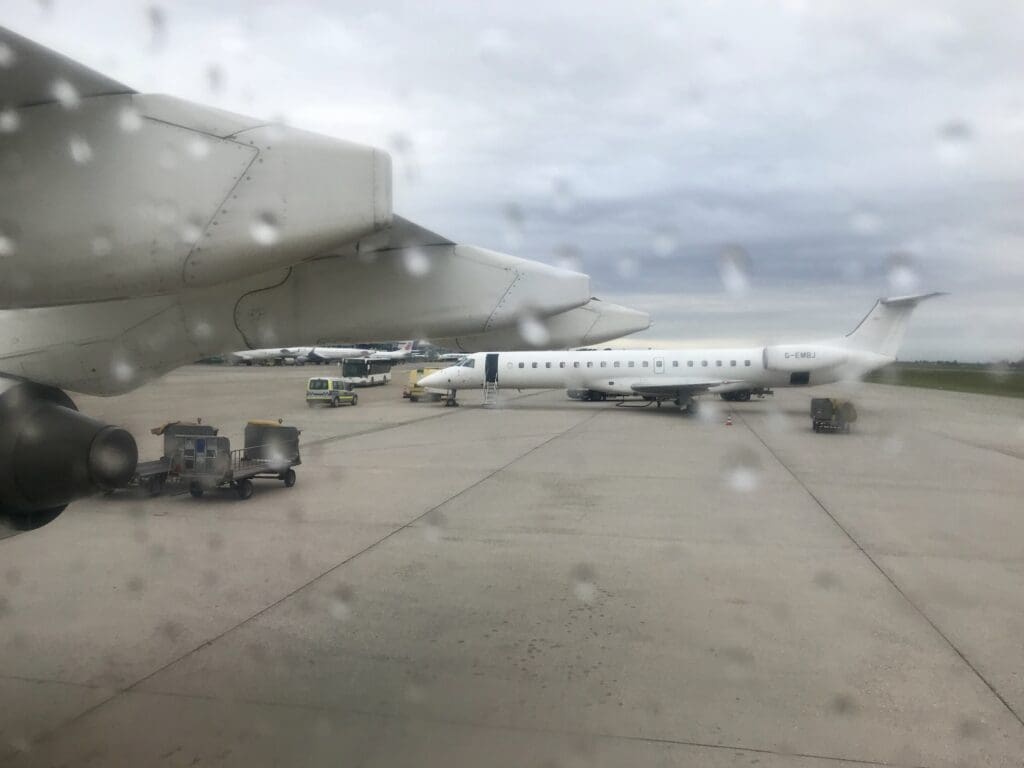
Living up to its reputation as the ‘Whisperjet’, as each small Lycoming ALF 502 engine powered up one by one, these seemed to produce nothing more than a slight hum. A few minutes later, the power levers were pushed forward and the aircraft made its way out of the stand and commenced its short taxi over to Runway 28. This journey took us past an Air Berlin liveried Dash 8 Q400 and a Vueling A320, before we reached the end of the runway and came to a short halt. Moments later, ‘Airfrans 12 Alpha Echo’ taxied onto the runway where we paused again for a few seconds.
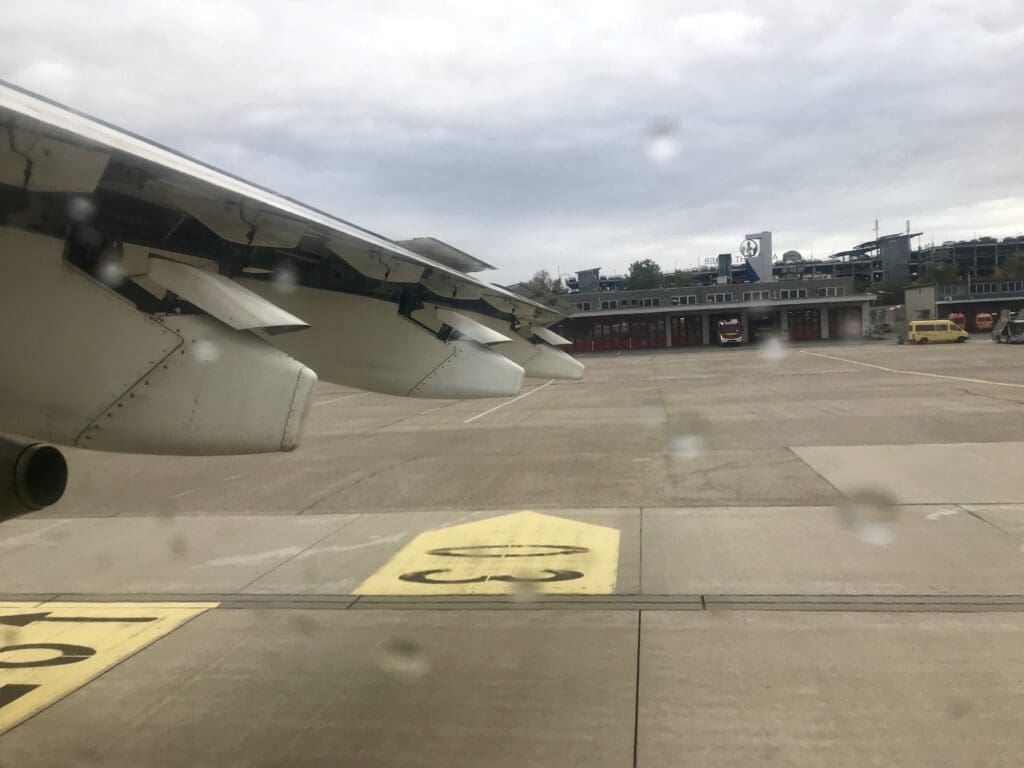
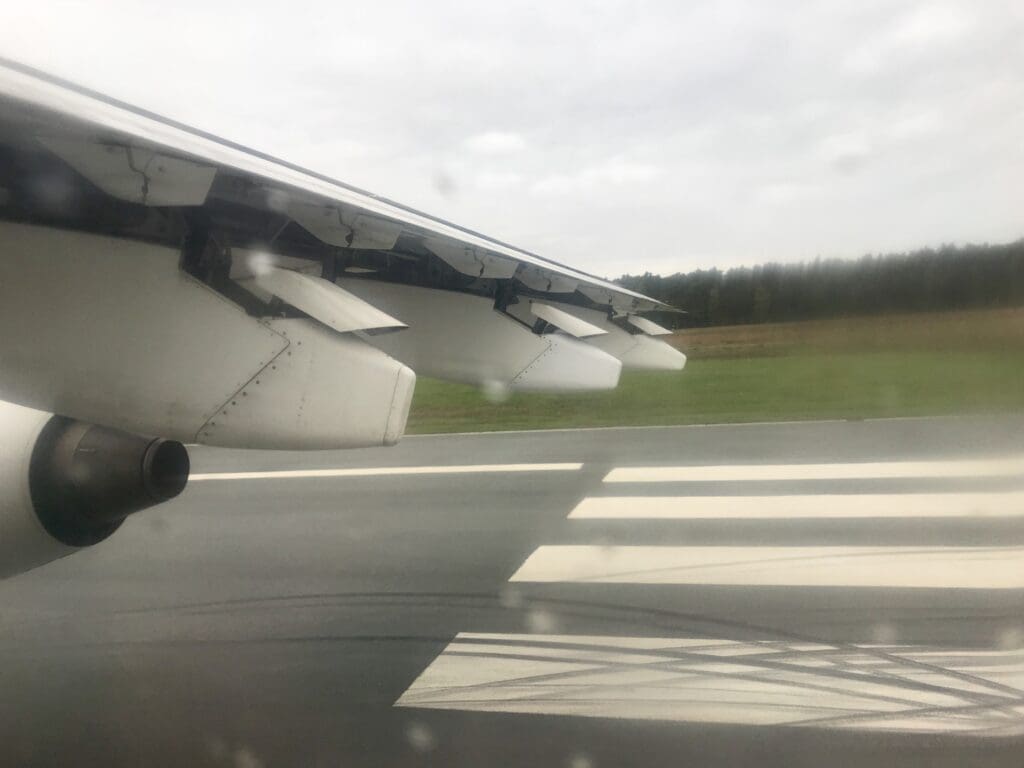
At 1459, the slight hum of the Whisperjet changed to a roar, suggesting that those who gave the type this name were used to the noisy jets of the past, without considering that the march of technology would mean that the BAe 146’s status as a ‘quiet’ airliner would one day become near laughable! Rapidly accelerating down the runway, given the regional quadjet’s short take-off capabilities, unsurprisingly, it wasn’t long until the nose was pointed skywards and we rocketed into the overcast Bavarian skies. During the first few seconds of the flight, plenty of vibration could be felt, although this soon subsided, with the exception of the cabin panelling around my seat which seemed to vibrate for the duration of the flight.
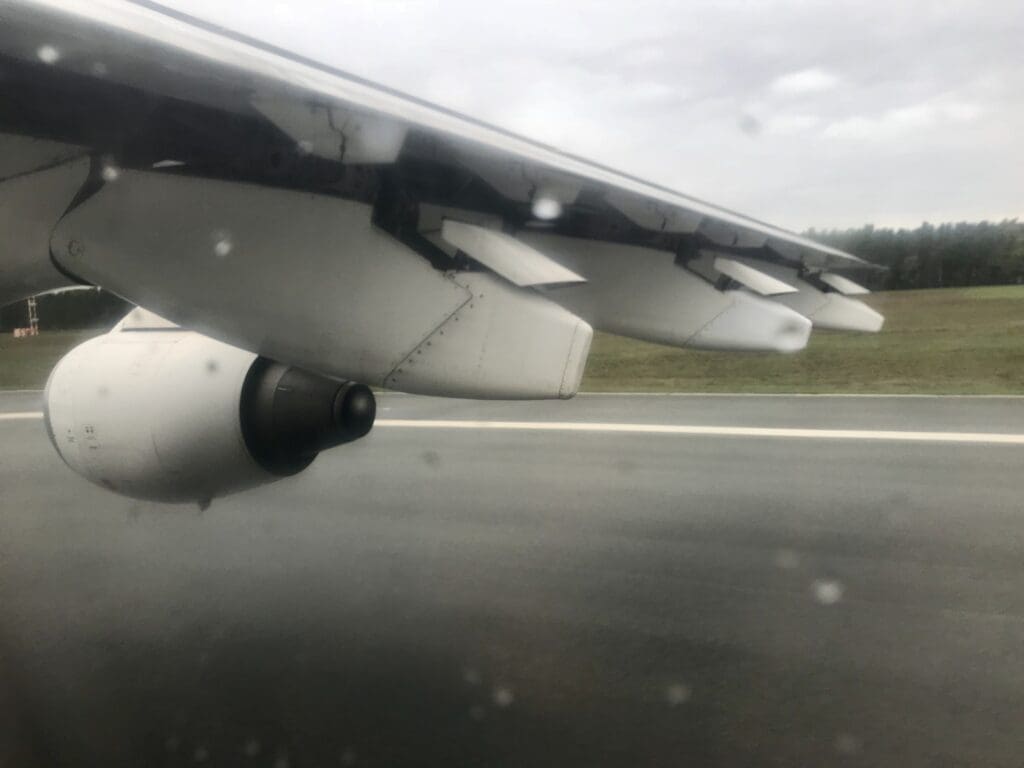
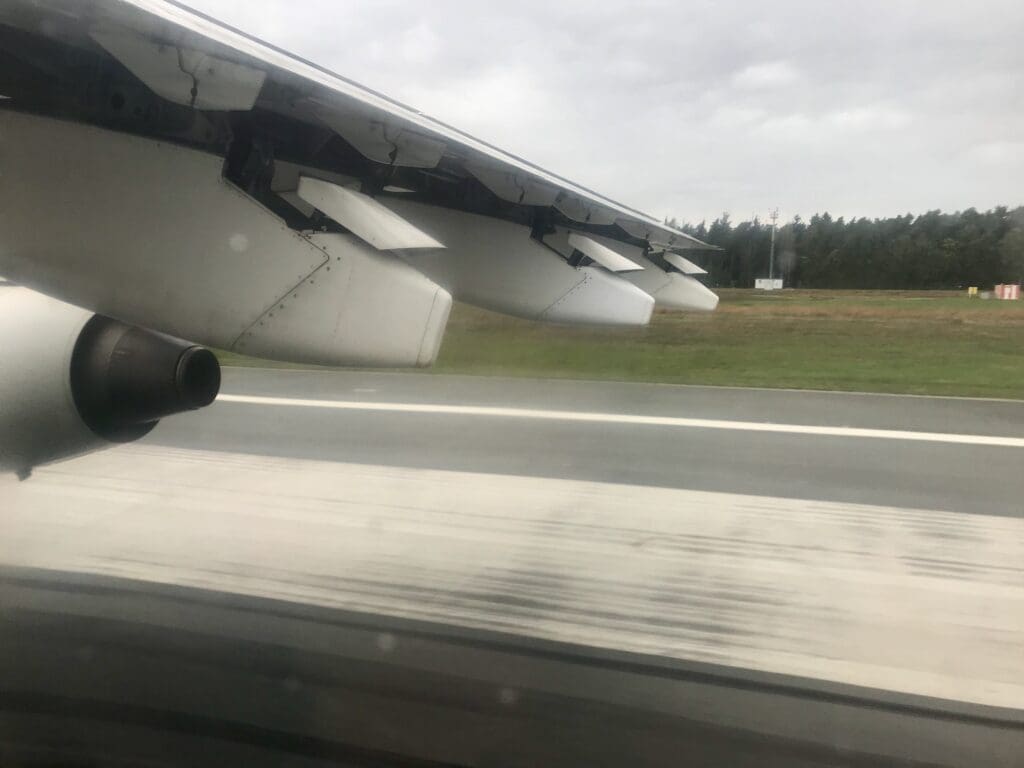
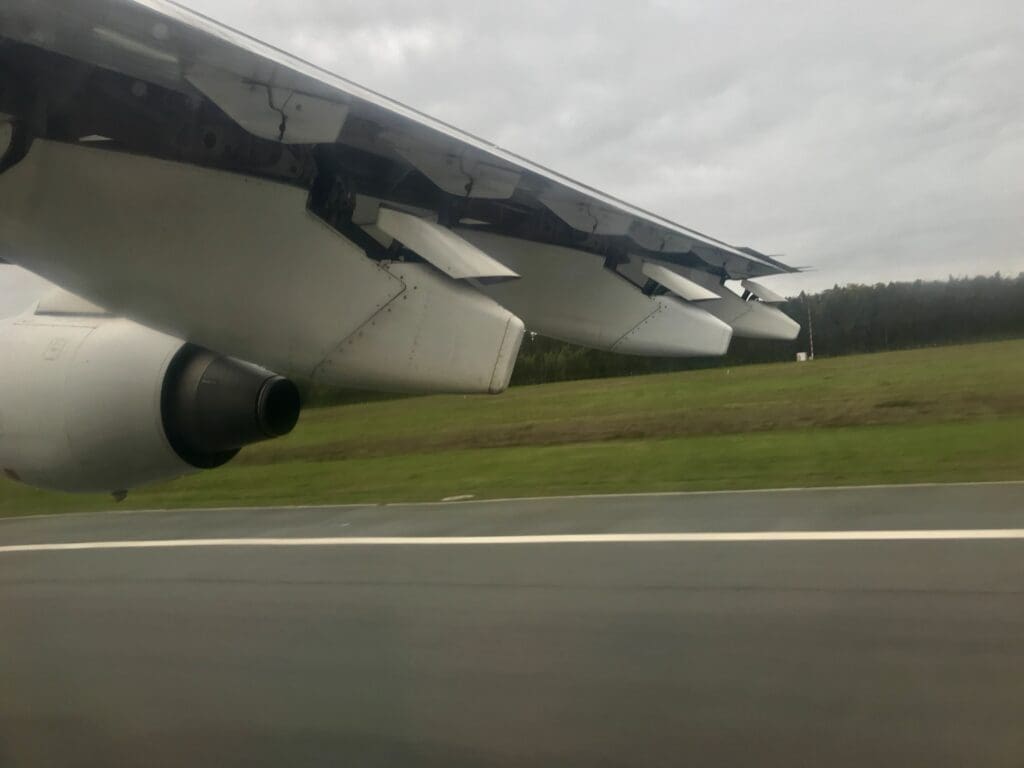
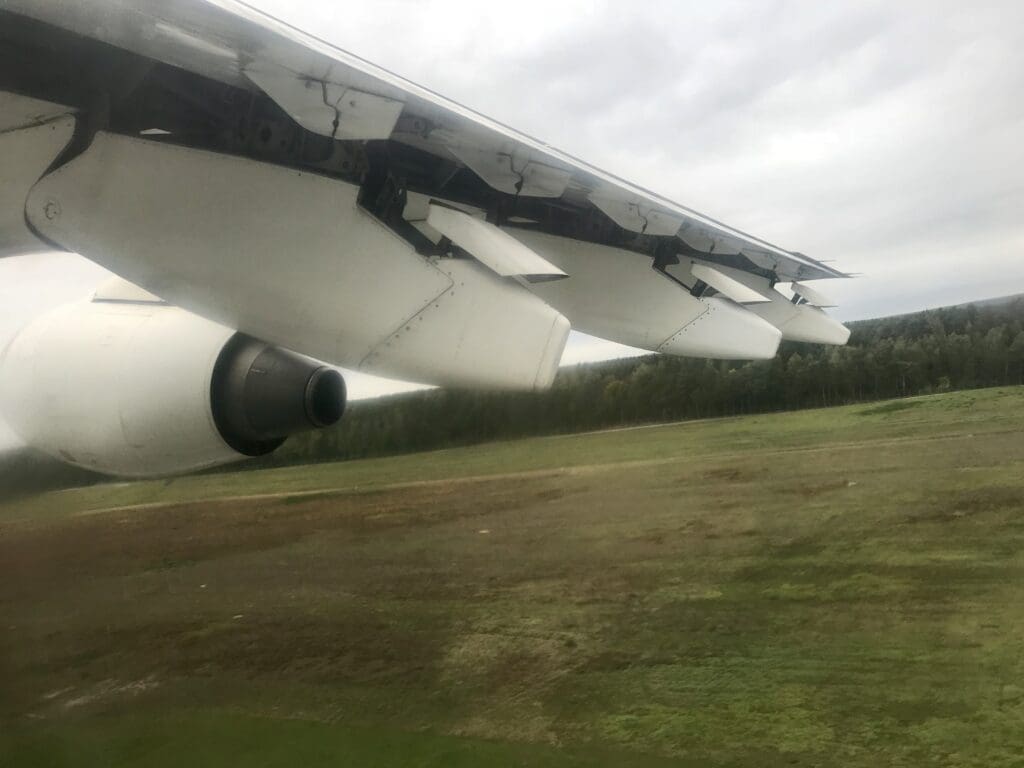
With a breezy wind blowing, unsurprisingly the aircraft was thrown about somewhat over the green fields around the airport, something that continued as we climbed into the clouds before finally reaching the clear blue skies a few minutes later. Seeing as I had been awake since 0400 and had minimal sleep the night before, with little to see of Germany below, I closed my eyes and had a short nap. Upon waking up, the aircraft had just reached its low cruising altitude of 24,000 feet and the snack service had passed my way and was heading forward. That afternoon, all Economy passengers were handed a drink of their choice and a packet that contained a couple of small cakes. By the time the crew finished this service, I notified them that I hadn’t been served and was offered a drink, but no snack. Perhaps having run out, this was no major issue, although I did find the flight attendant that I interacted with to be somewhat cold and brash, leaving me with far from the best impression.
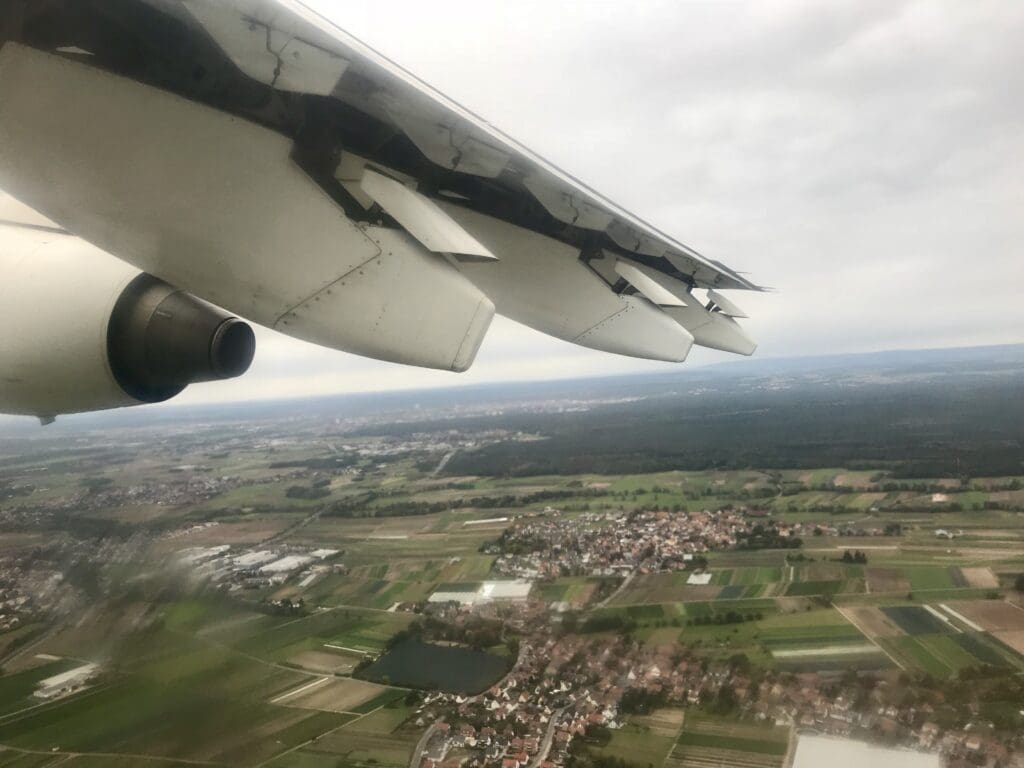
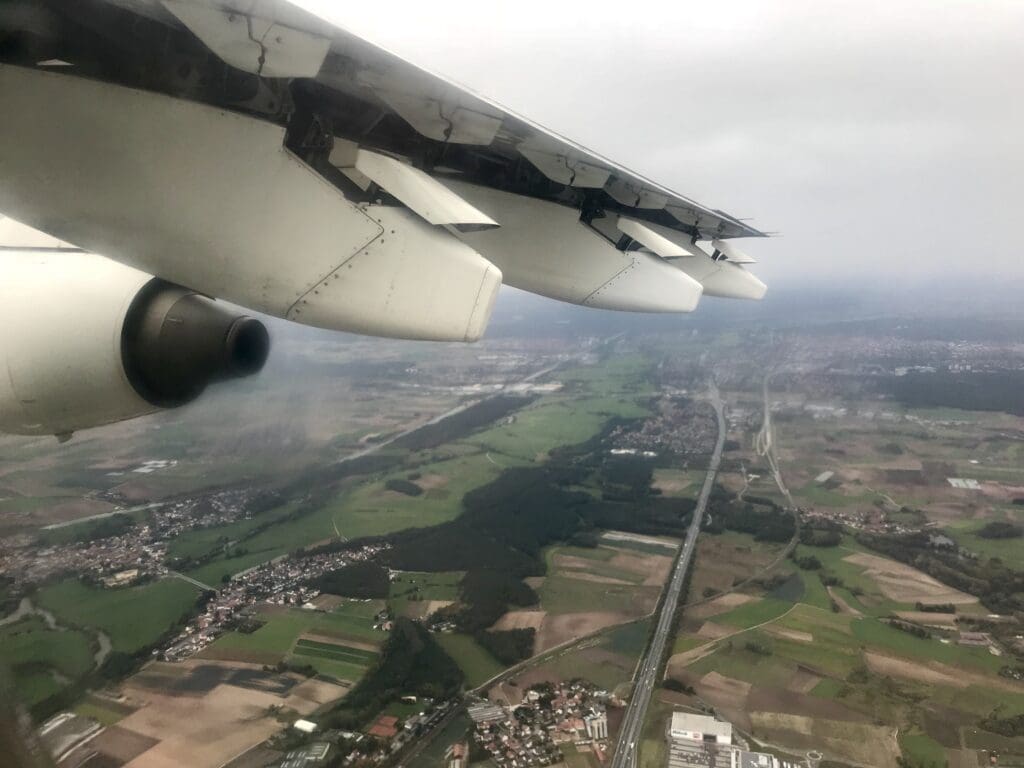
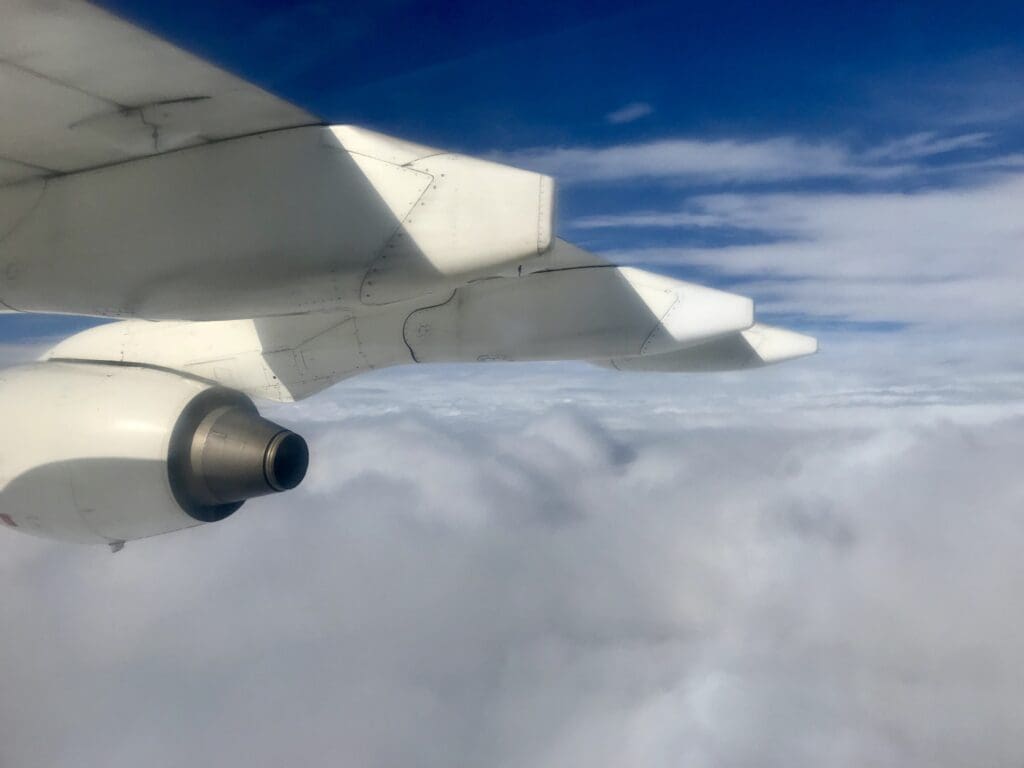
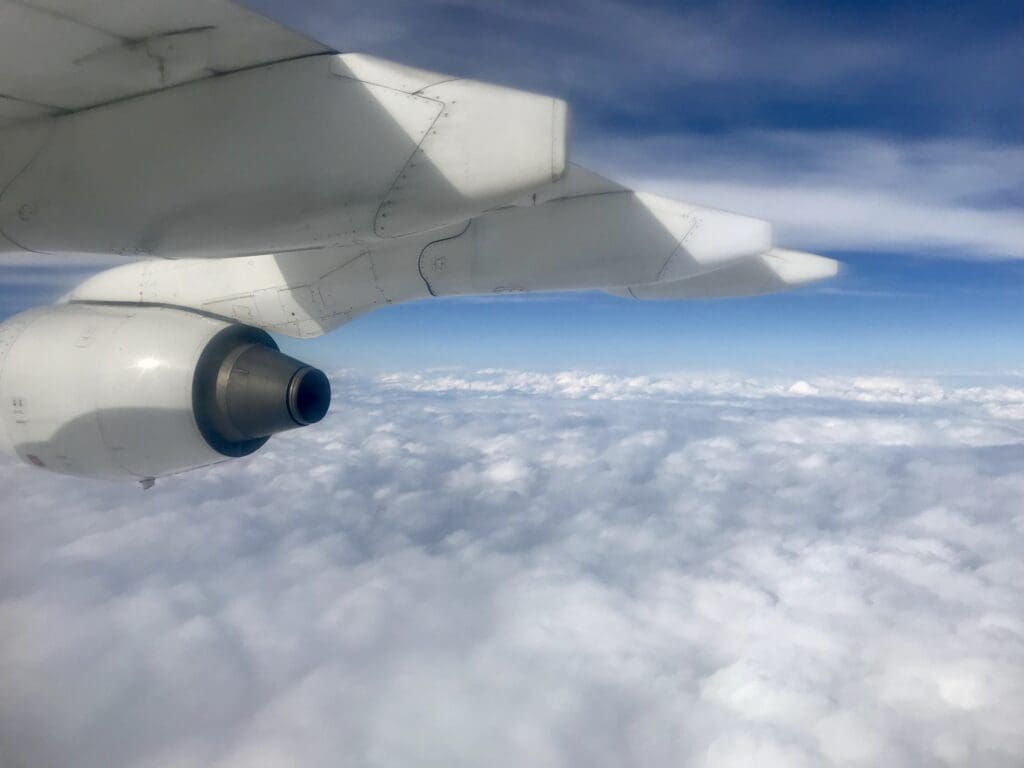
As we continued to cut westwards through the skies of France, nothing could be seen of the ground below the aircraft. Later on, a quick check of FlightRadar24 revealed that after departing Nuremberg, the aircraft had travelled a short distance northwards before flying westwards over the skies of Southern Germany, crossing over the likes of Wurzberg and Mainz before leaving Germany behind and passing over the small country of Luxembourg and the southern tip of Belgium, making another slight adjustment to our course once we entered French airspace.
At 1556 as we passed to the northeast of the city of Reims, the cabin noise suddenly decreased and the aircraft pitched down hinting at the commencement of our descent into Paris CDG. A couple of minutes later, the seatbelt signs were switched on and the Purser cane back on the speakers informing us of our descent. We first flew down to 10,000 feet at a descent rate of around two thousand feet per minute before gently turning southwards and continuing our descent at a slightly gentler rate.
As we entered the thick cloud layer, once again things started to get rather bumpy. In the cabin, the crew appeared to pick the wrong time to conduct their pre-landing checks and appeared to be clinging onto seats as they checked the cabin, after this an announcement was made informing us that we would arrive at terminal 2G. At around 7,000 feet, the aircraft’s rear speed brakes could be felt being deployed as we continued to slow down during the descent. As we were still in the thick cloud and remained in this until we were on final approach, there was no way to judge how close we were to the airport until our flaps were gradually extended and the gear came down. The extension of both created even more noise and vibration from the panel to my right.
Eventually, the rain soaked landscape around Meaux came into view and the flaps were fully extended. Despite leaving the clouds, the aircraft continued to be thrown about quite a bit by the high winds. After passing over several fields and large roads we bounced down over the airport’s perimeter and at 1619 we made a surprisingly soft touch down on Runway 26L. The aircraft’s seemingly large wing spoilers were then extended and we braked gently, continuing a long way down the runway before turning off. After this, we held almost immediately whilst a couple of Airbus A320s from Air France and EasyJet departed from Runway 26R. Behind us, a massive Air France Boeing 777-300ER completed its long flight from Tokyo Narita and joined us waiting, its passengers likely eager to escape the cabin. After being cleared to cross the runway, we made a quick taxi past the Air France giants at Terminal 2E towards the HOP! terminal, Terminal 2G.
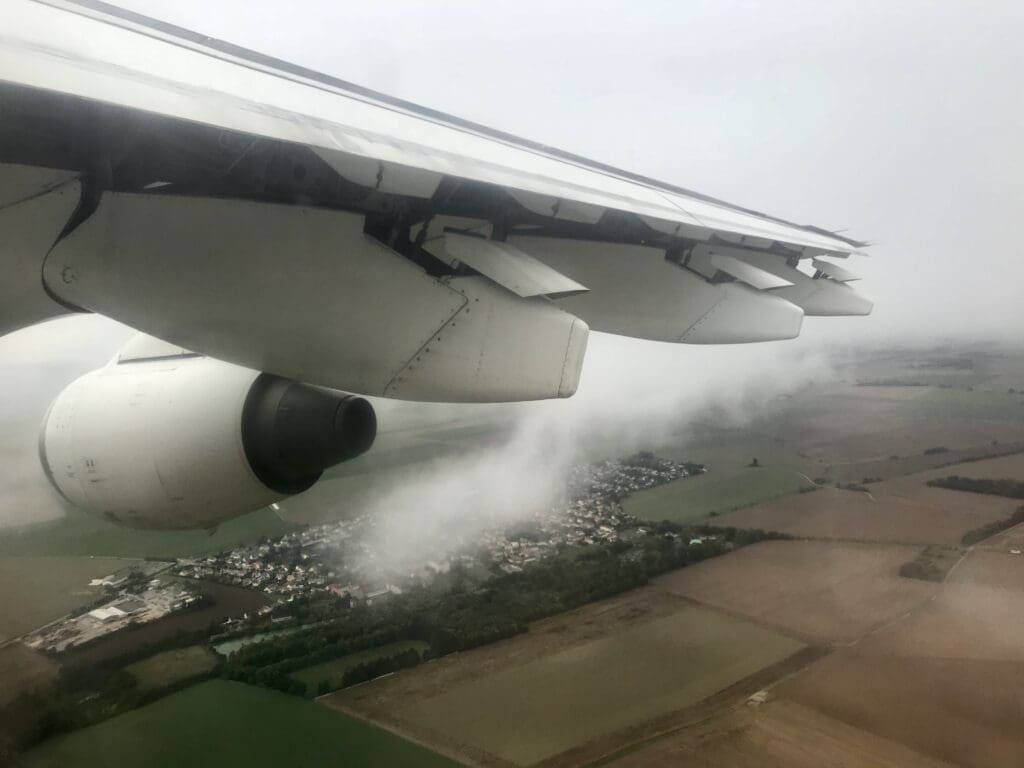
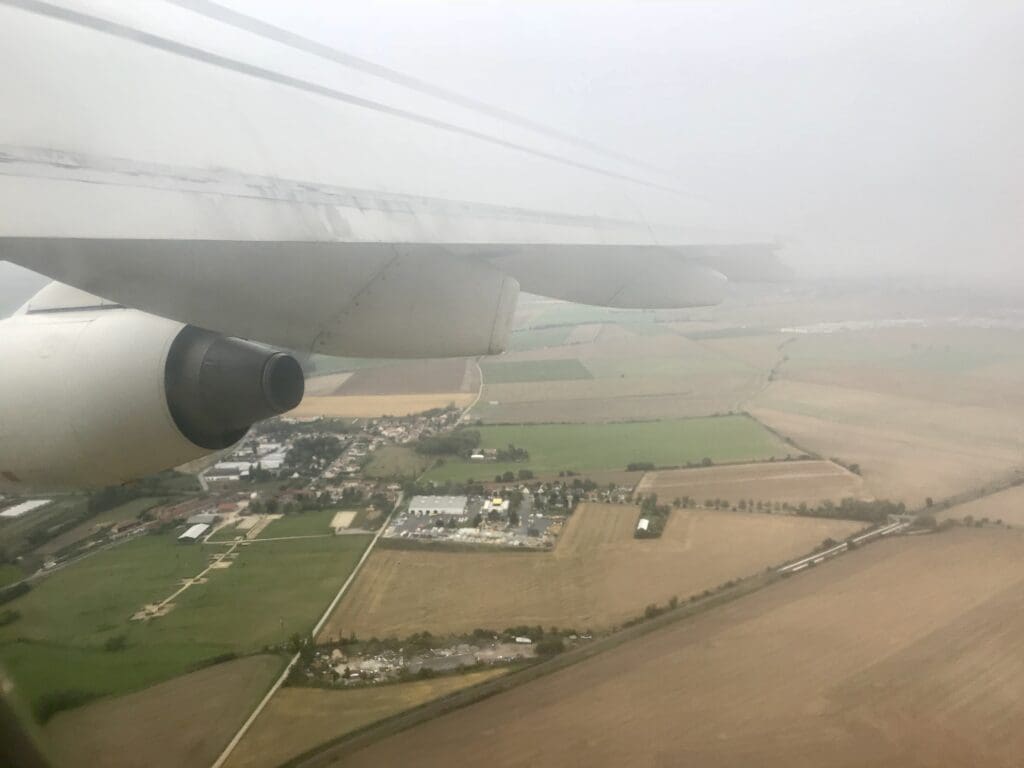
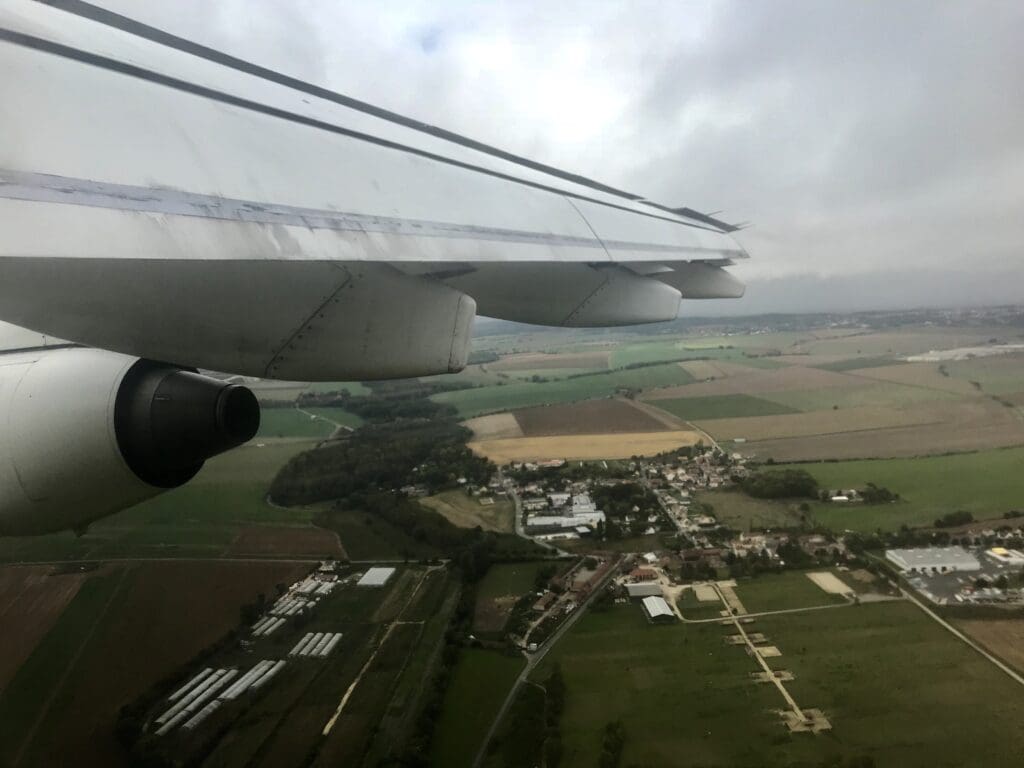
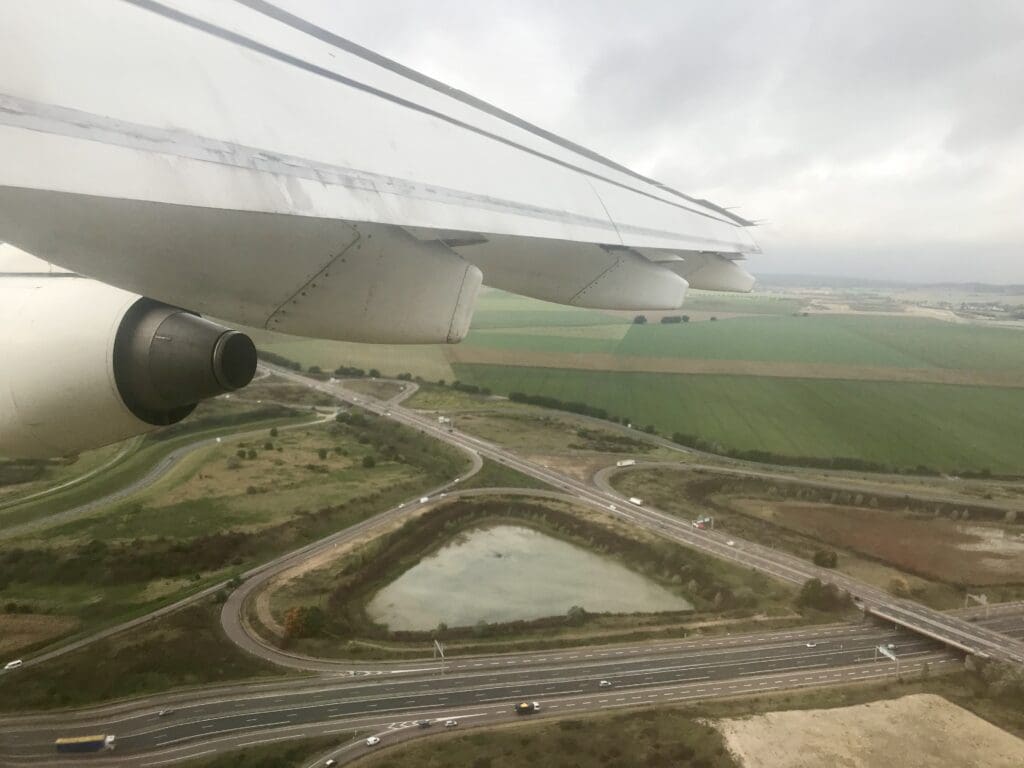
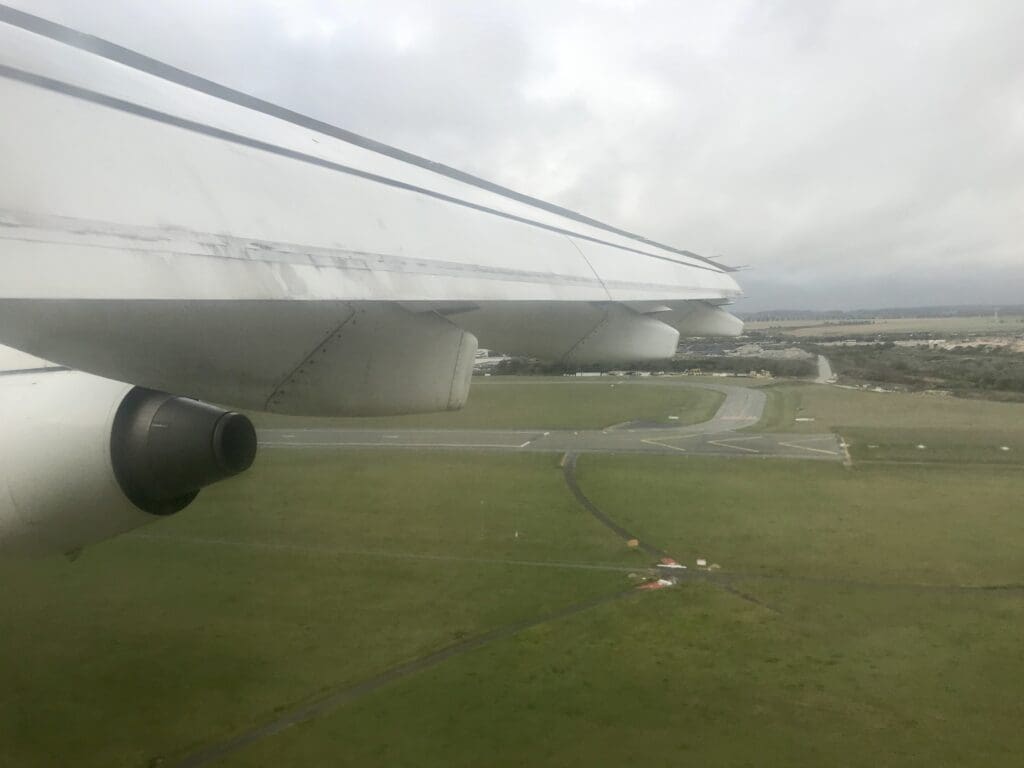
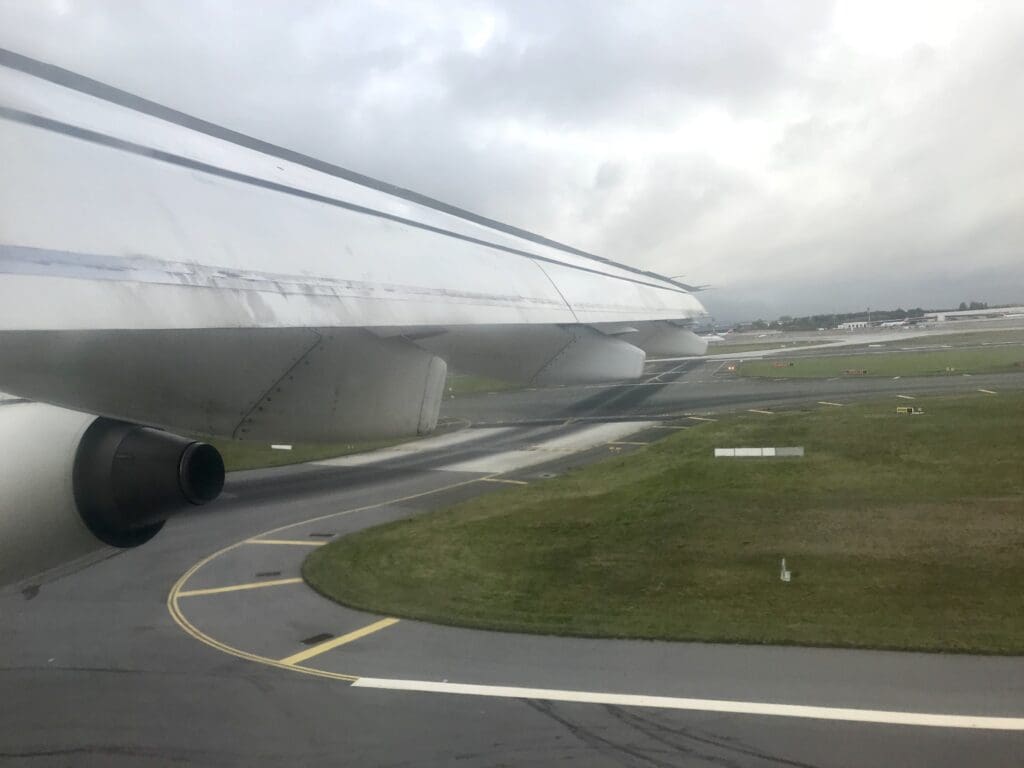
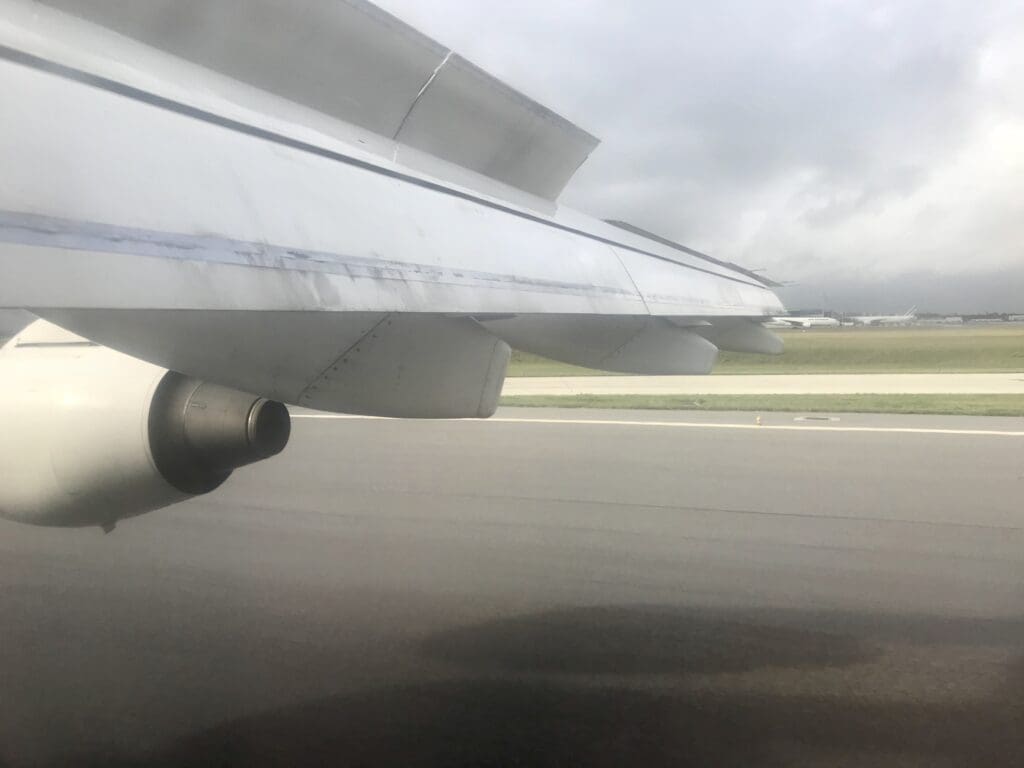

Eventually, we pulled up to our stand at the Embraer-dominated terminal and the engines were shut down which seemed to fill the cabin with the heavy scent of fuel. Once on stand, there was some wait before we were able to leave the aircraft, during which time the Purser made an announcement informing us that it was raining, allowing the passengers to make suitable preparations for the short walk into the terminal building. Disembarkation soon began and I was thanked in French by the purser before disembarking the aircraft.
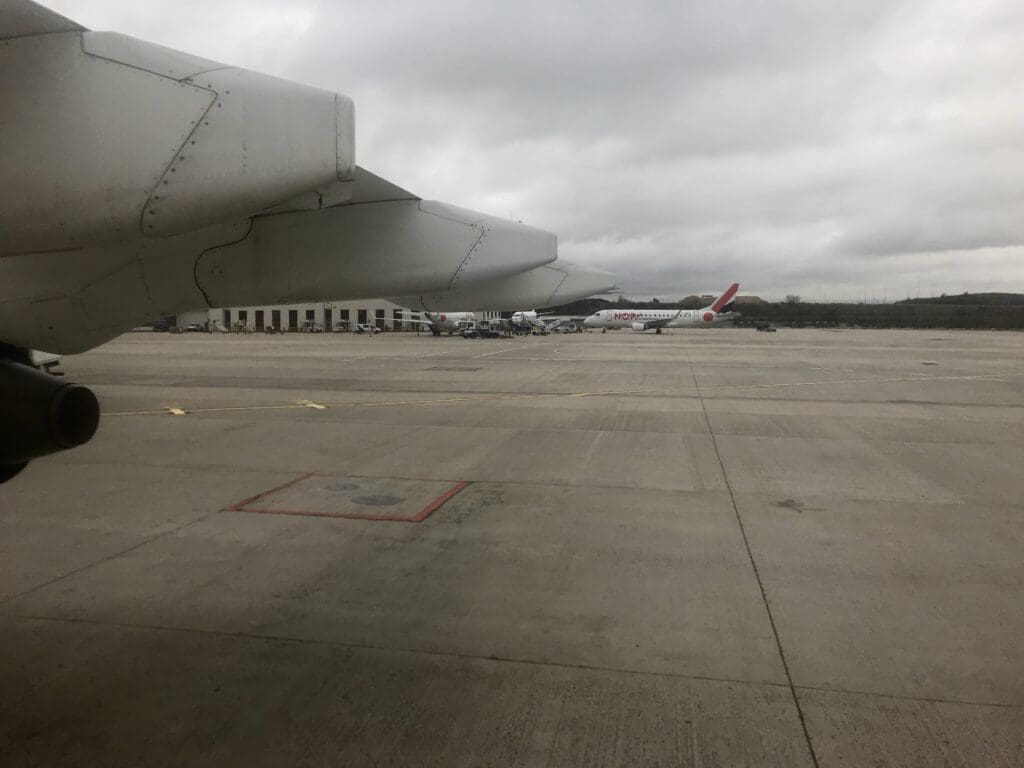
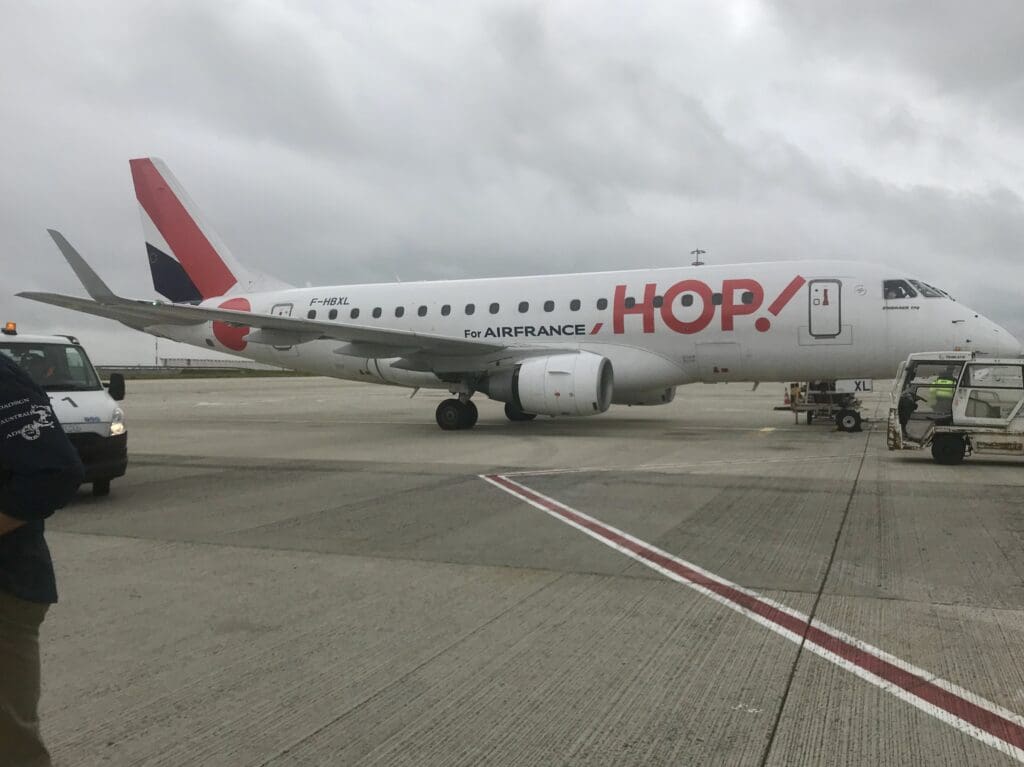
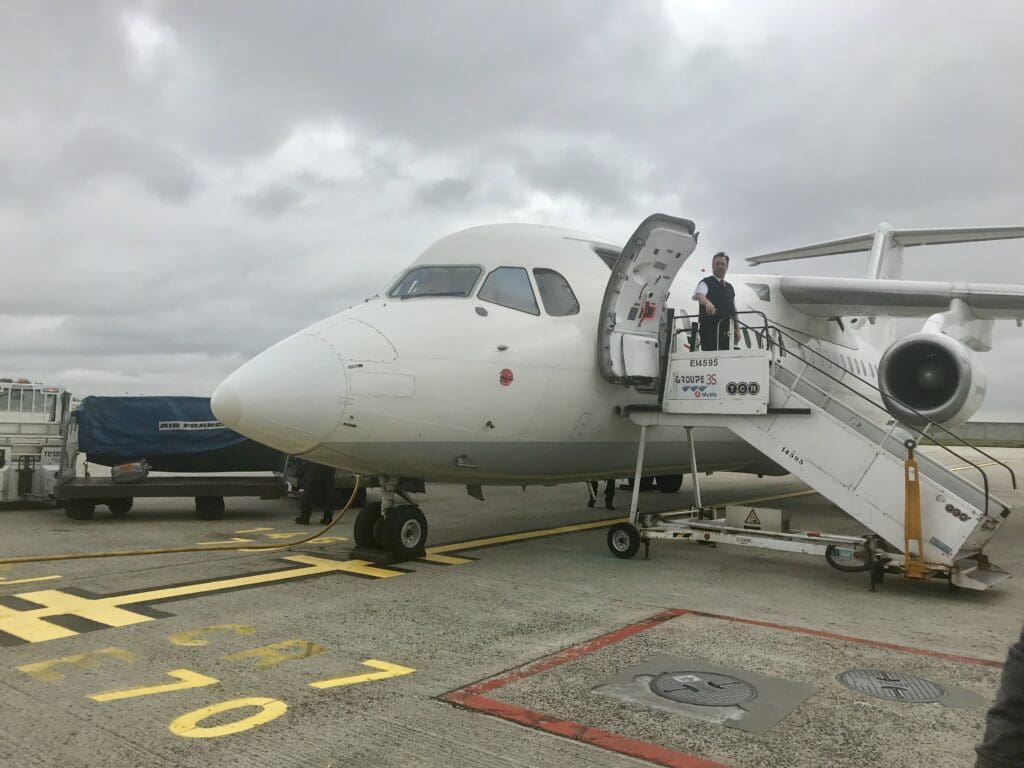
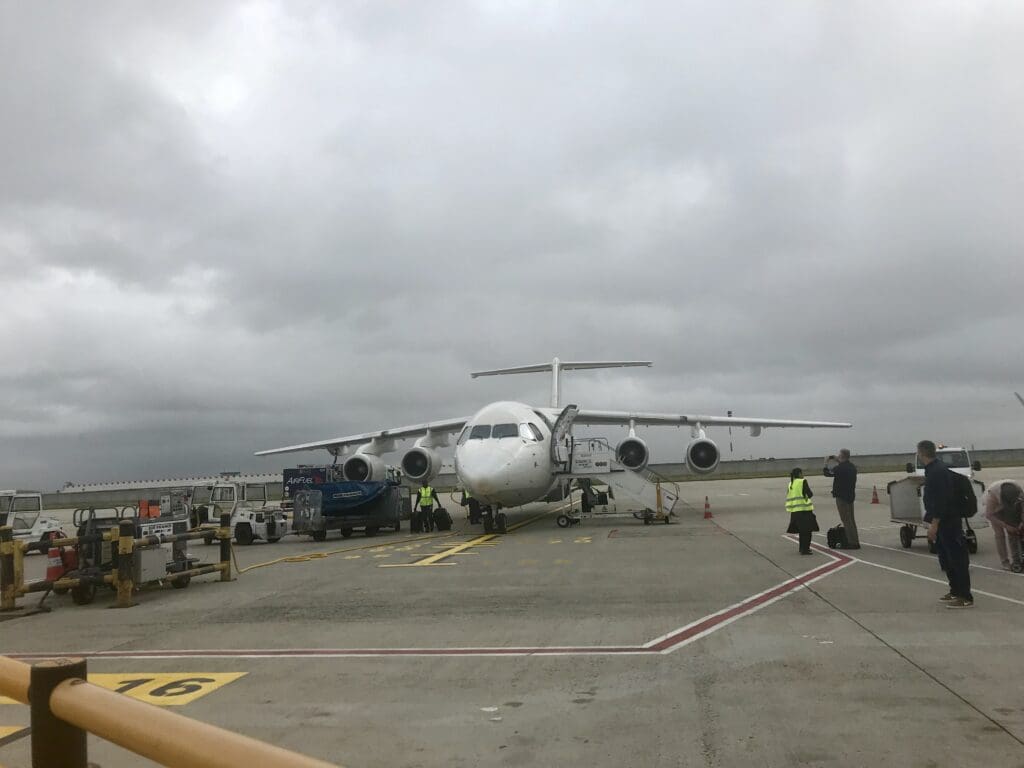
From the outside, the square-like jetway-less structure that is Terminal 2G makes the terminal seem as if it caters for LCC carriers, whilst on the inside its relative basicness reinforces this. A strong contrast to the more upmaket K gates area of Terminal 2E which I then headed onto via bus after an immigration check. Whilst I will not offer a full review of this, my Airbus A319 flight up to Heathrow was a pleasant experience that left me with few complaints.
Summary
Inside, the aircraft was nothing but comfortable with large seats and good legroom. I was pleasantly surprised by the good state of the cabin and so I have no complaints here. Whilst the crew were okay, most of my interactions were with the unhappier crew member and so that sort of but a slight downer on my experience. Fortunately the crew of my next flight made up for this and so I would be happy to fly Air France again!
To end, here are some photos from the short Air France Airbus A319 flight to London Heathrow that I connected onto:
